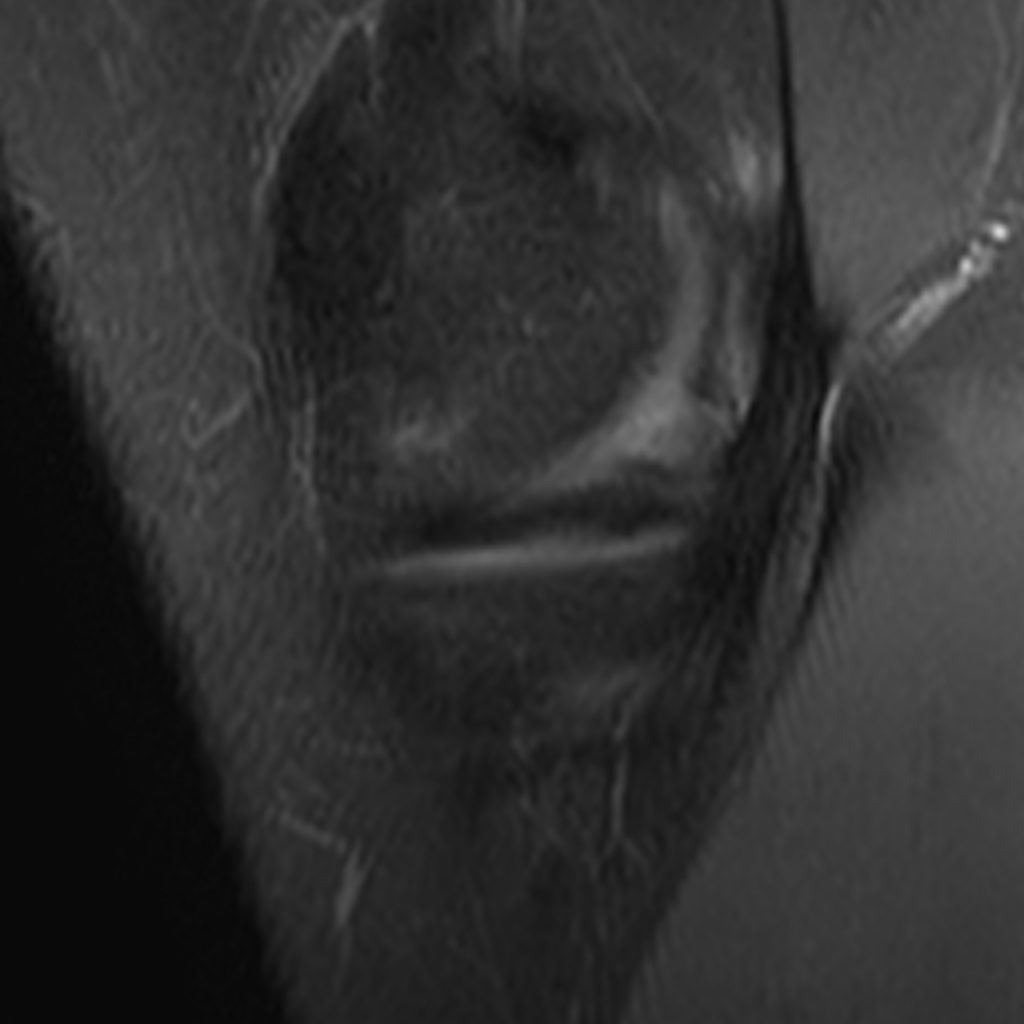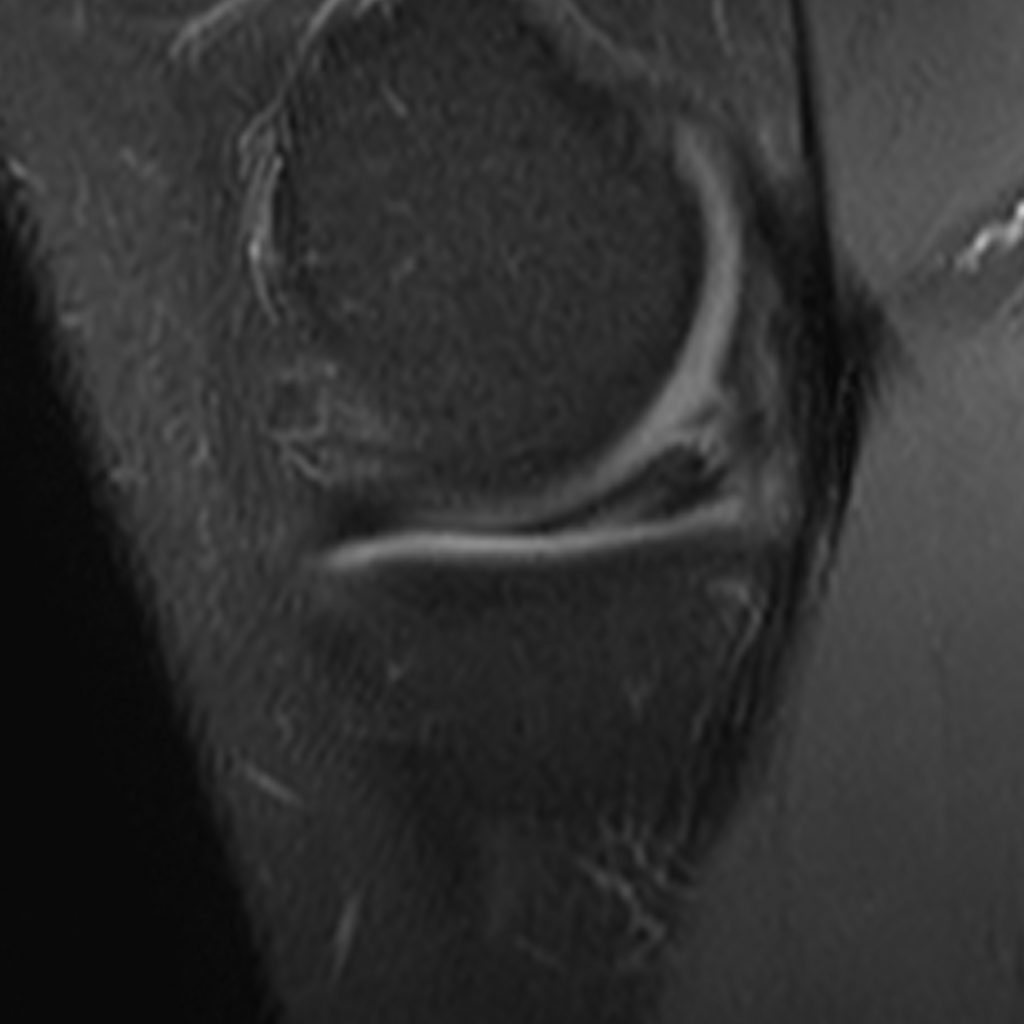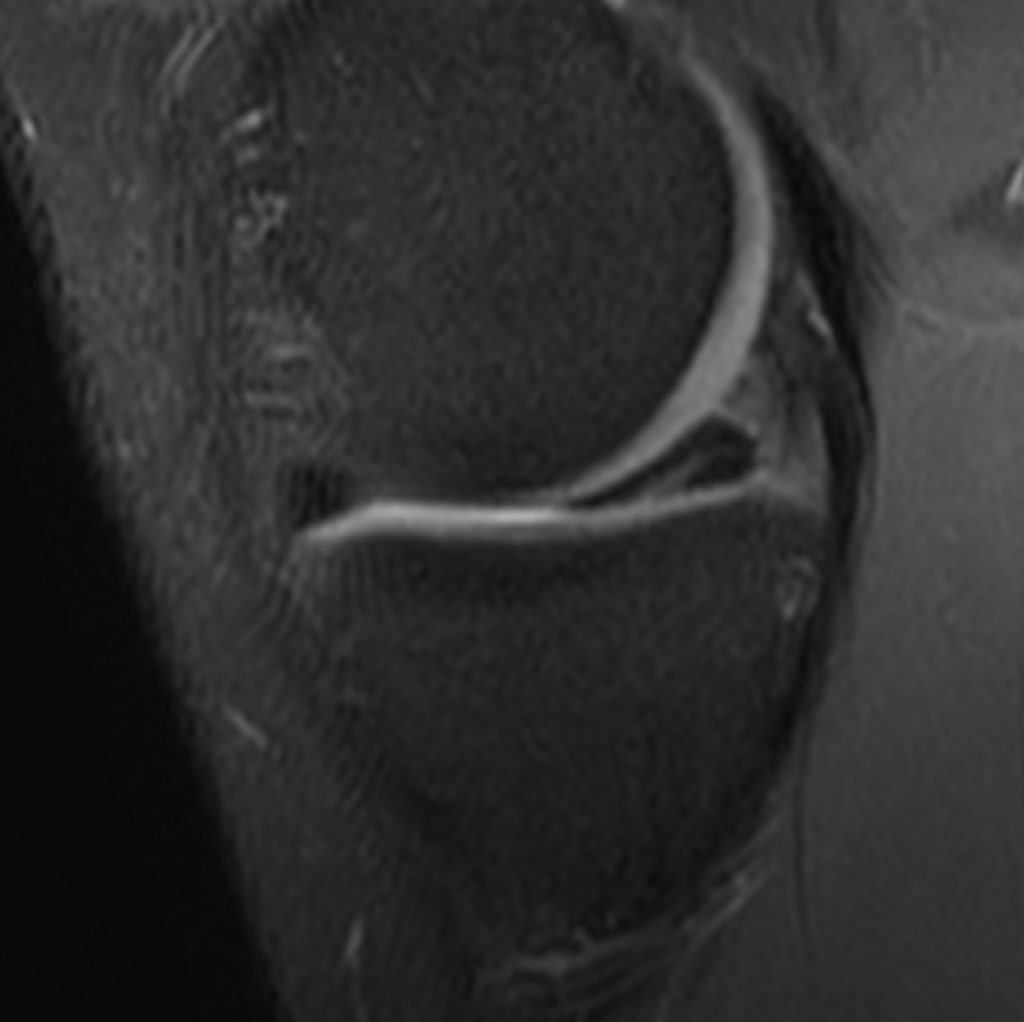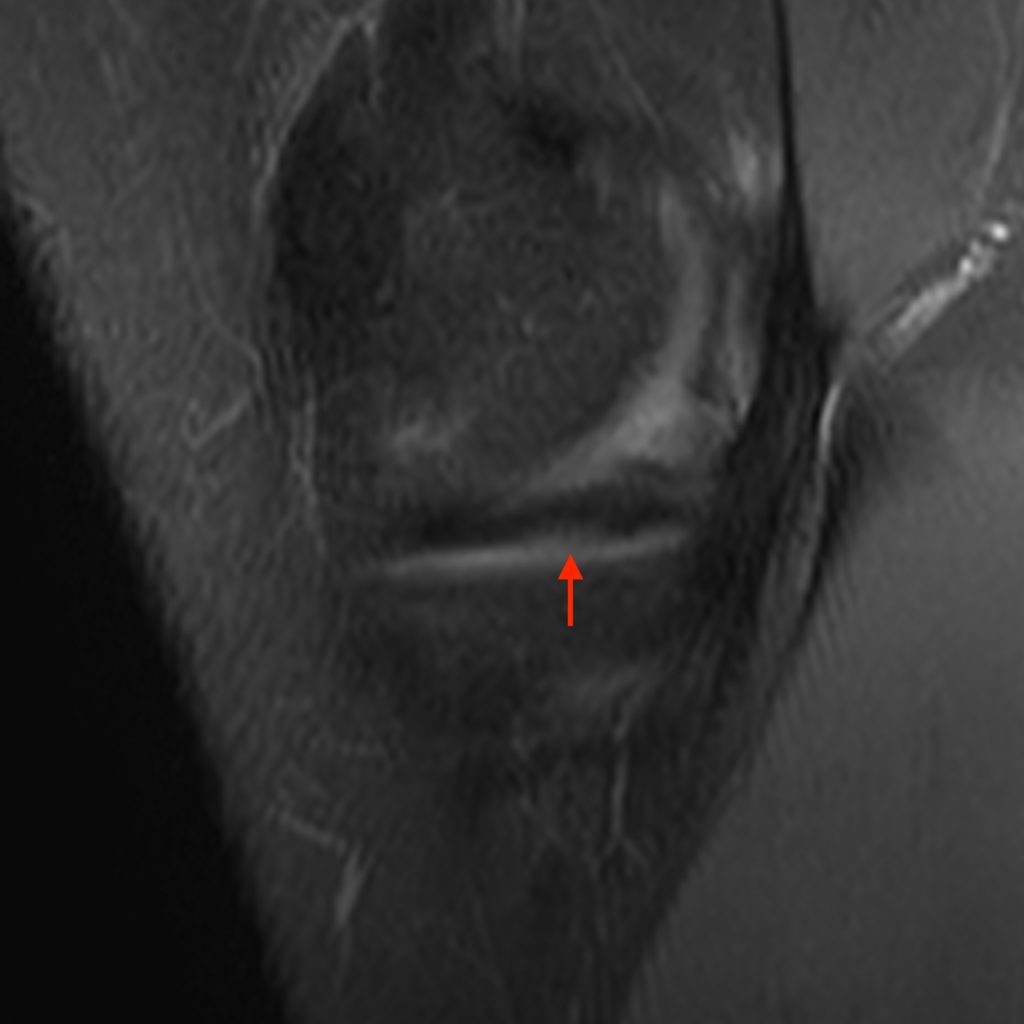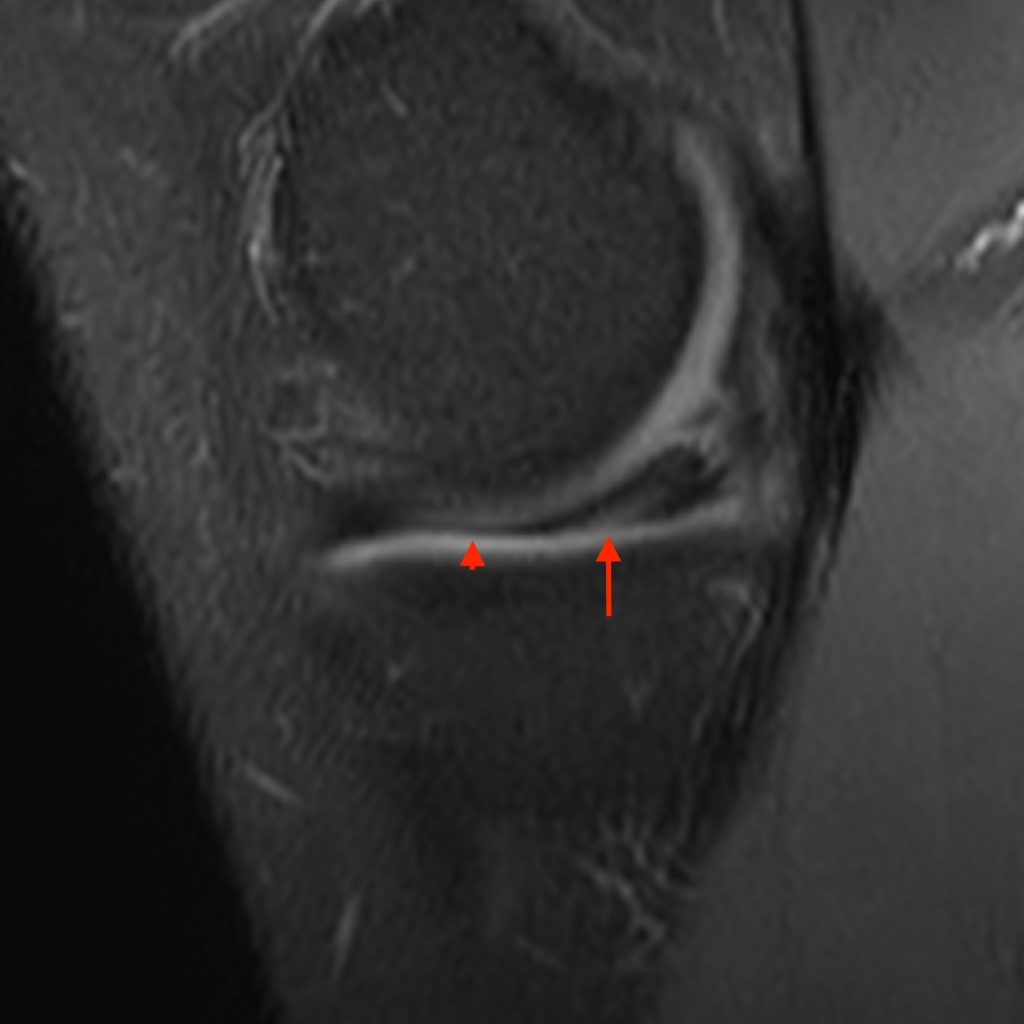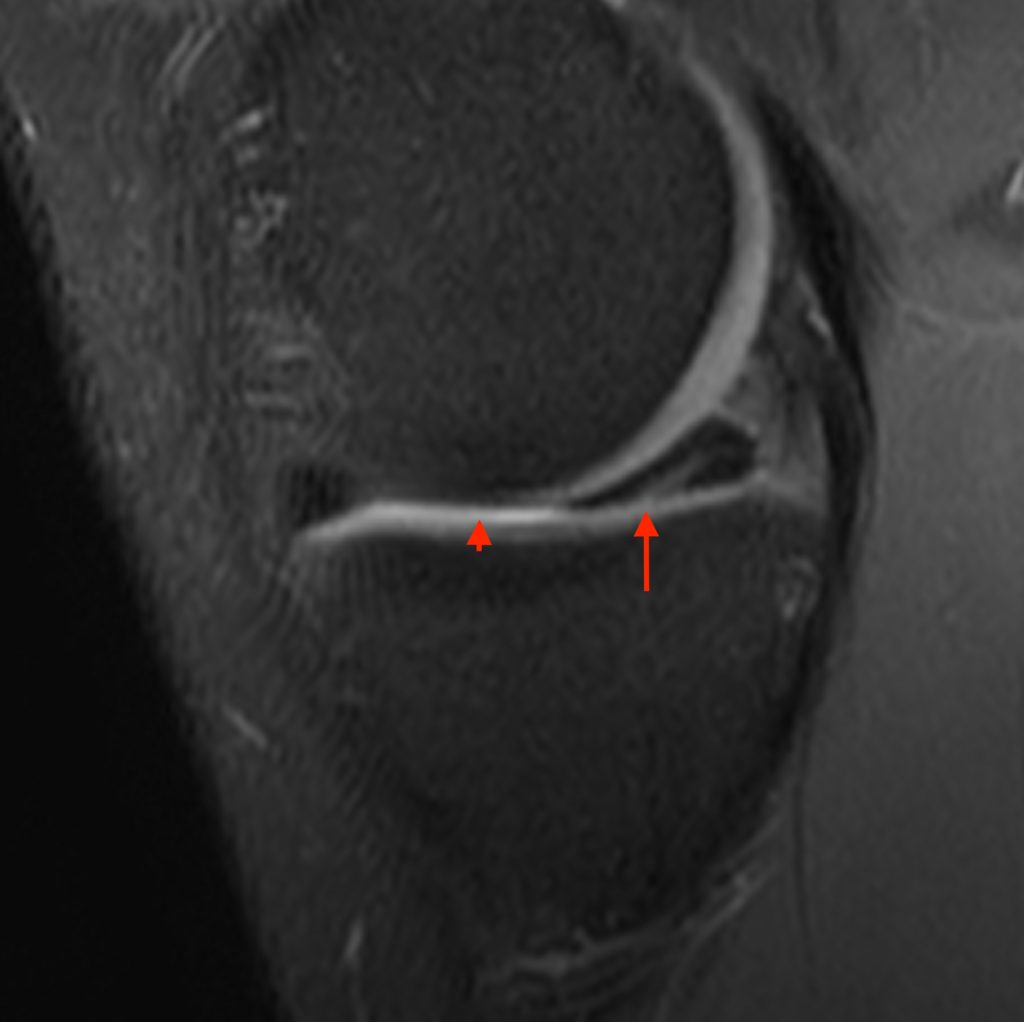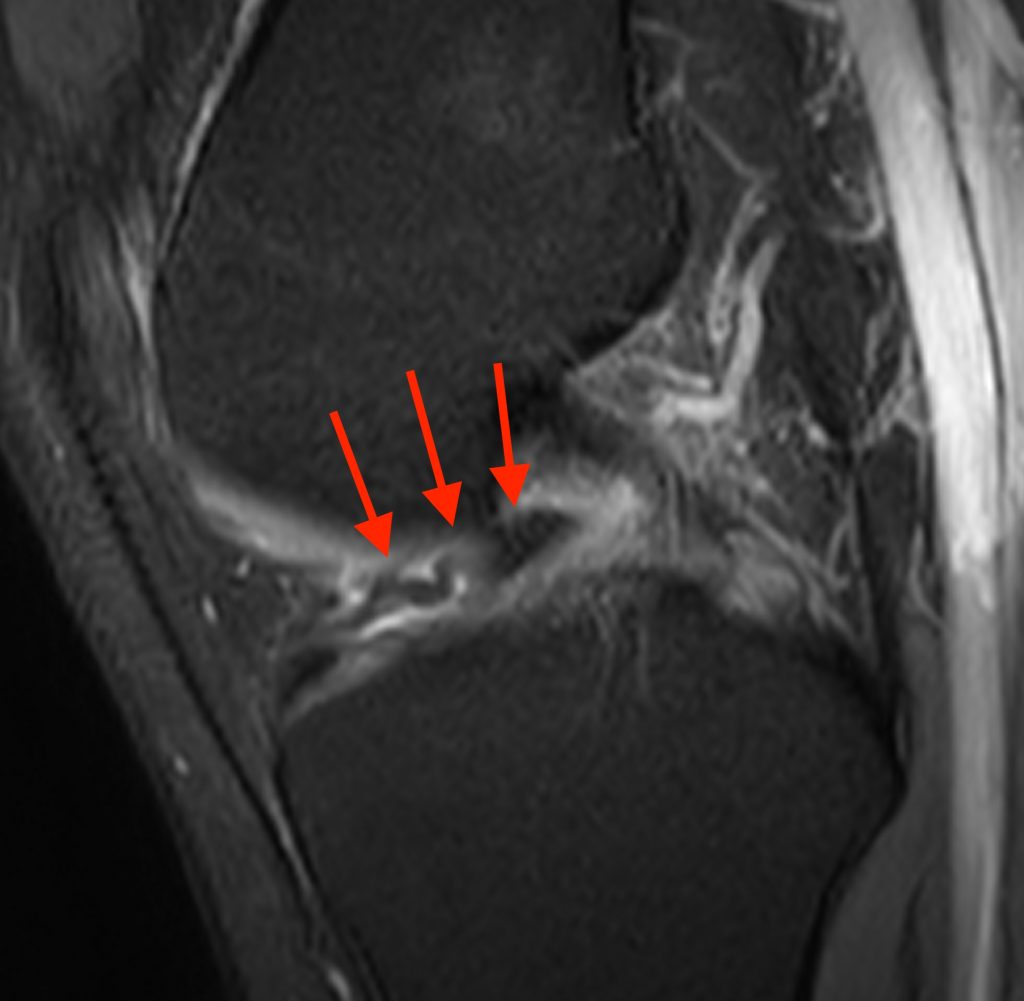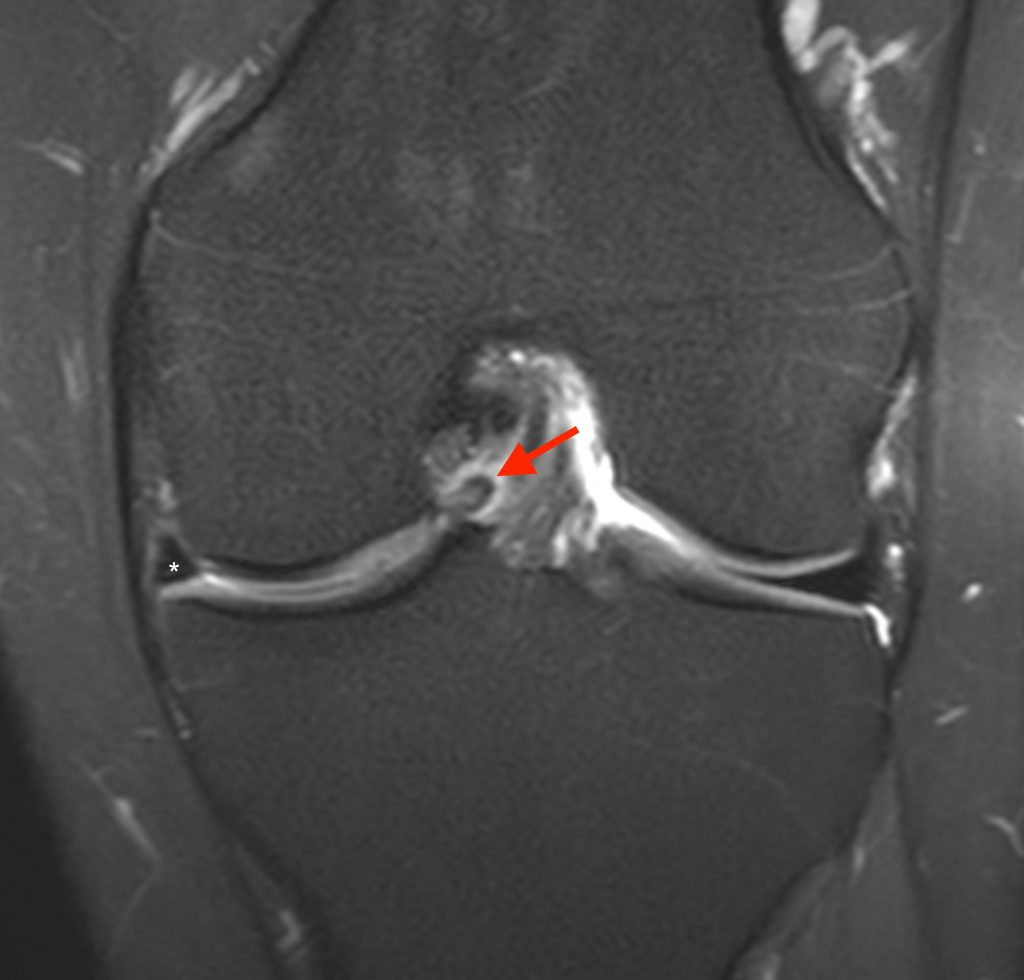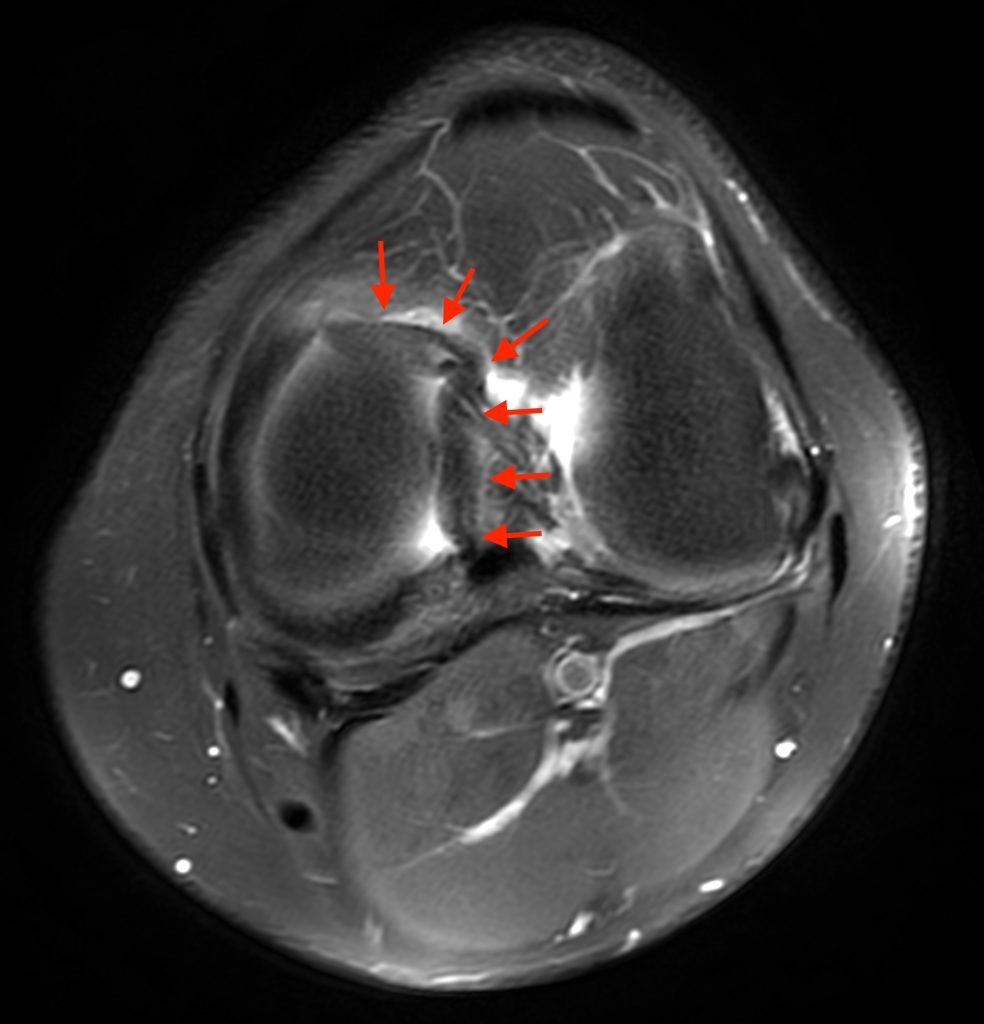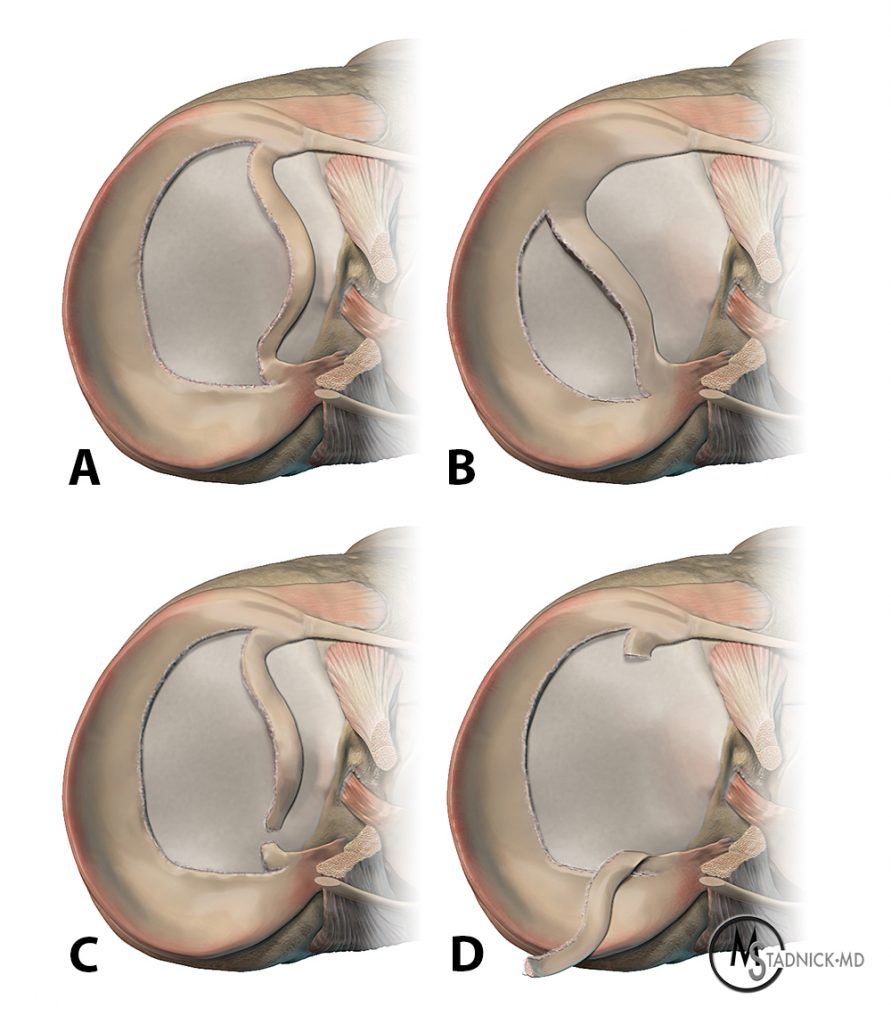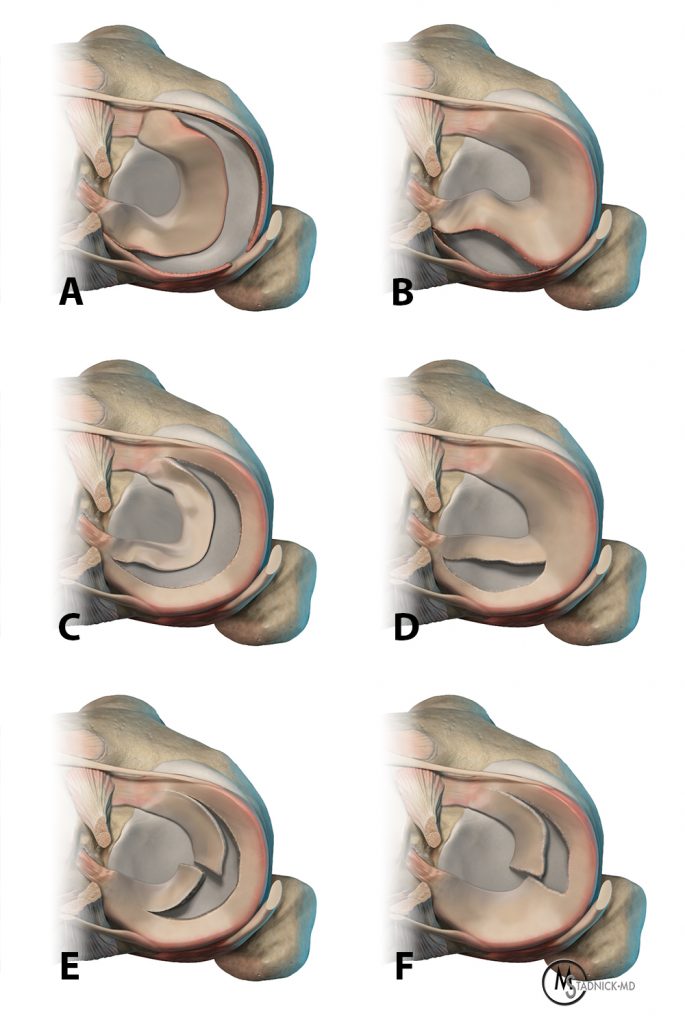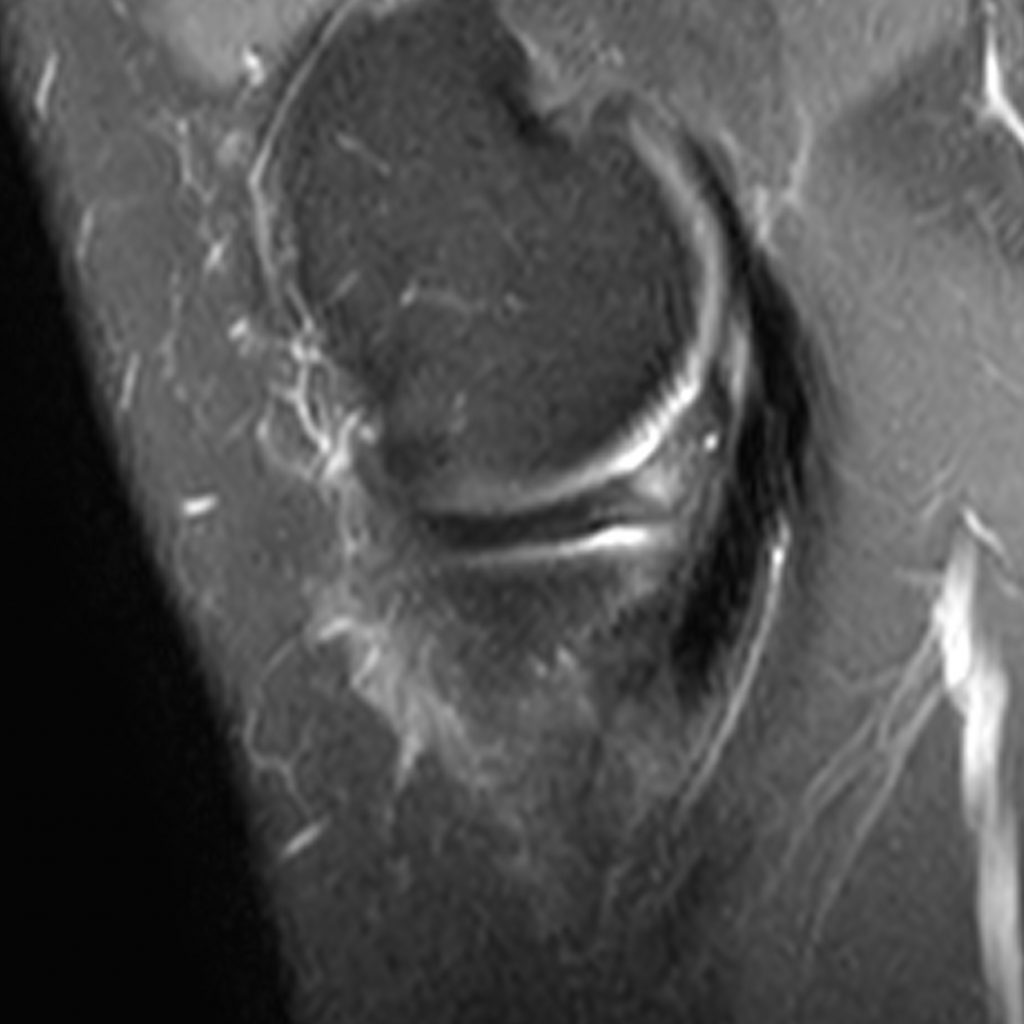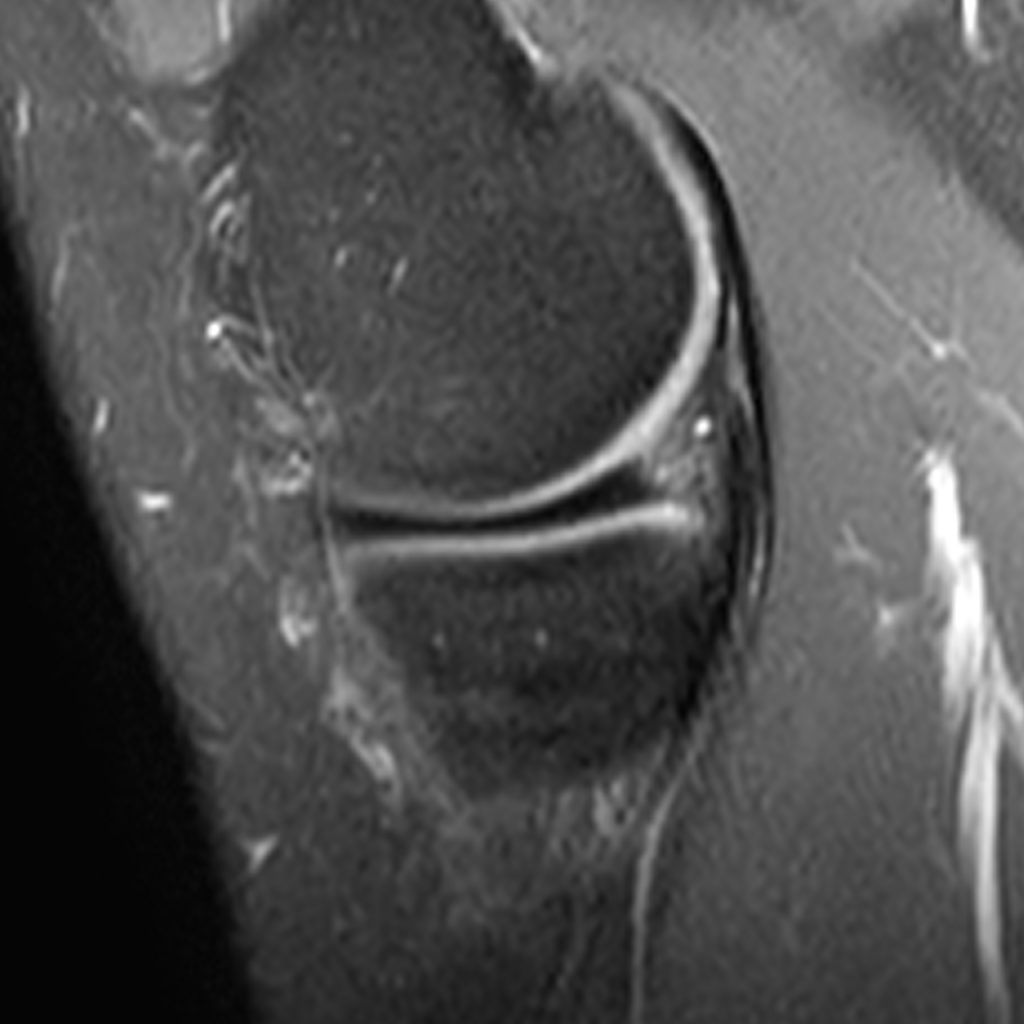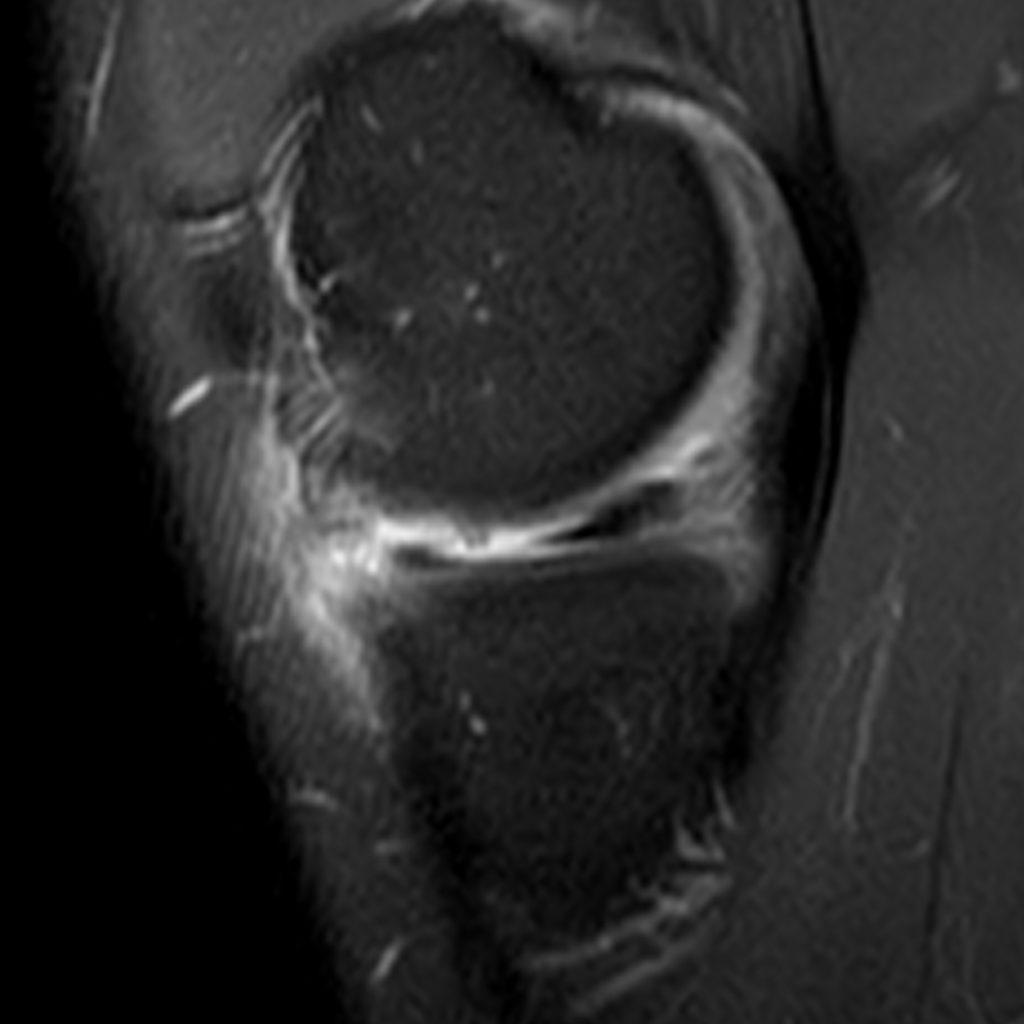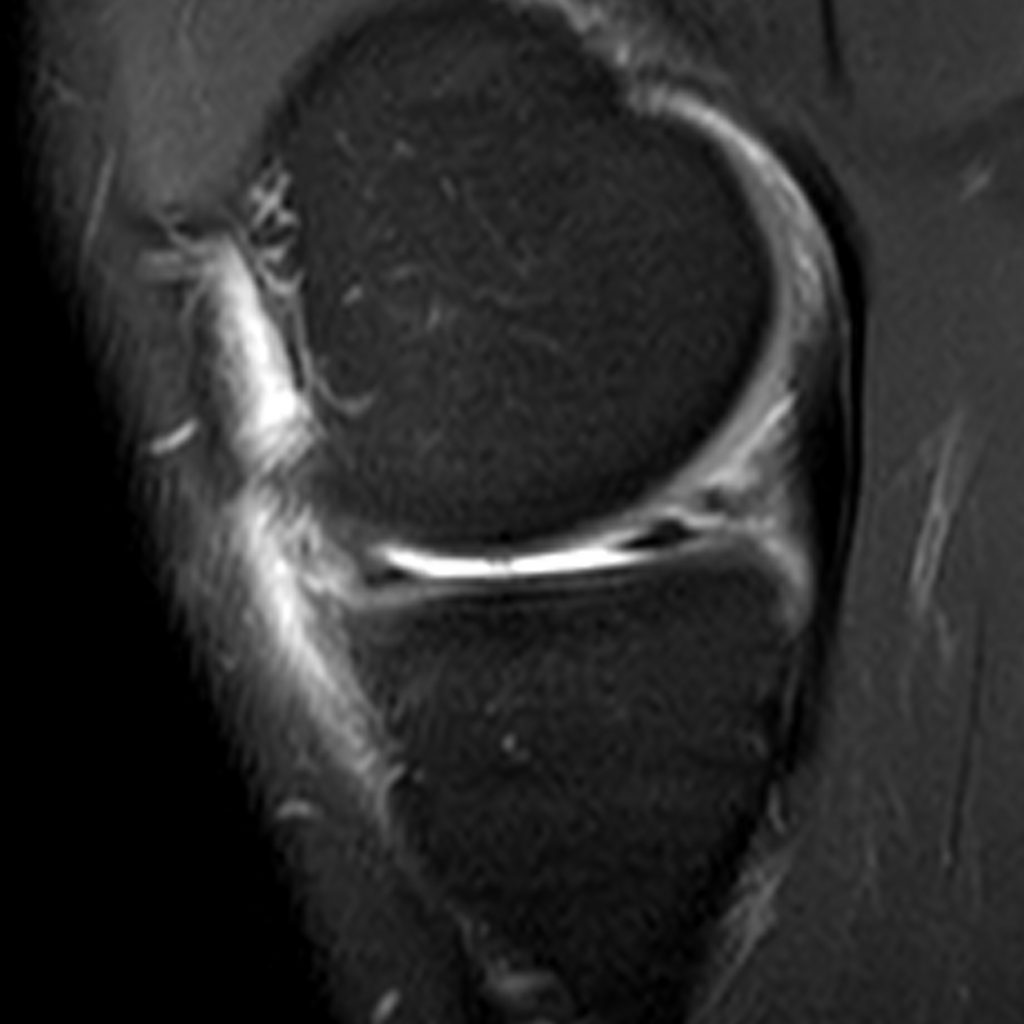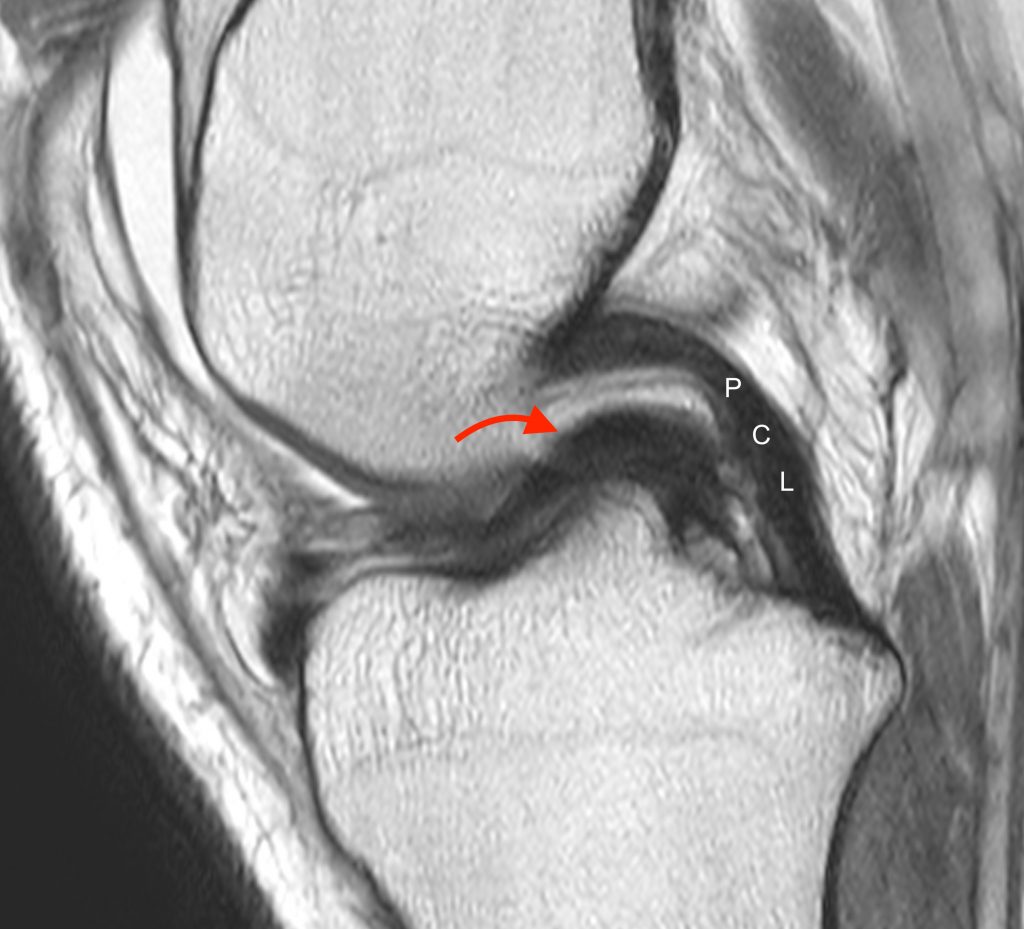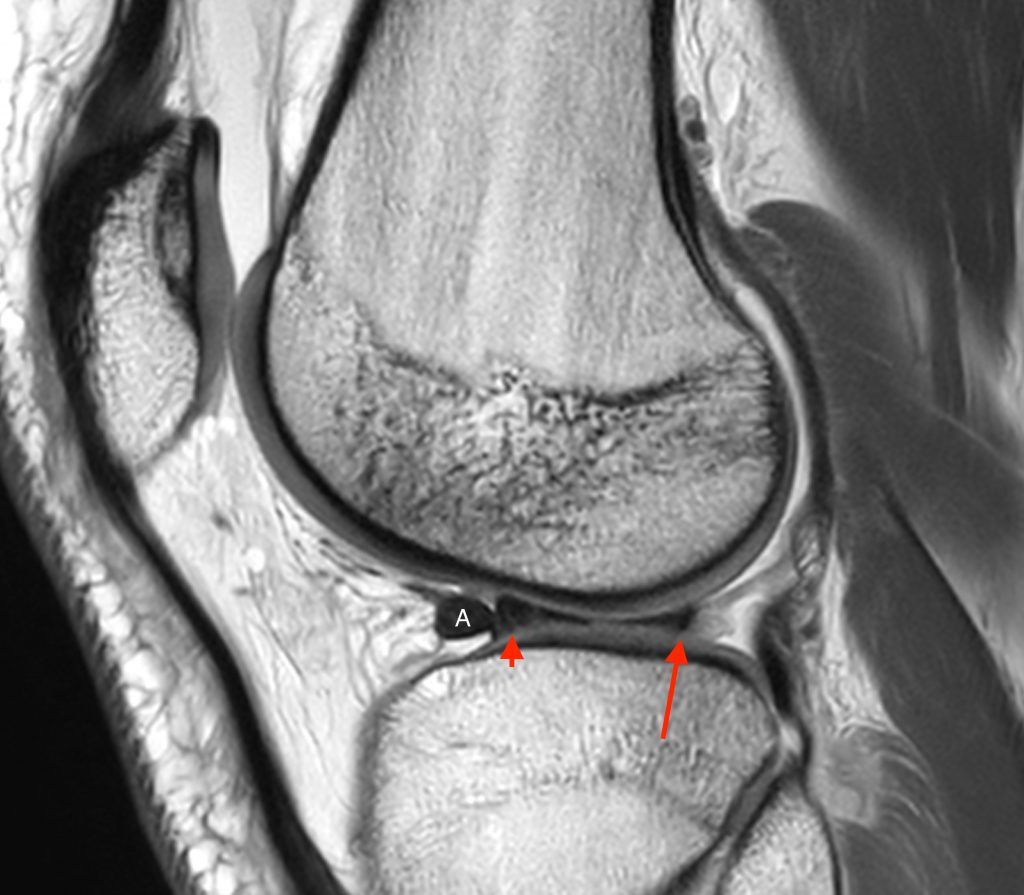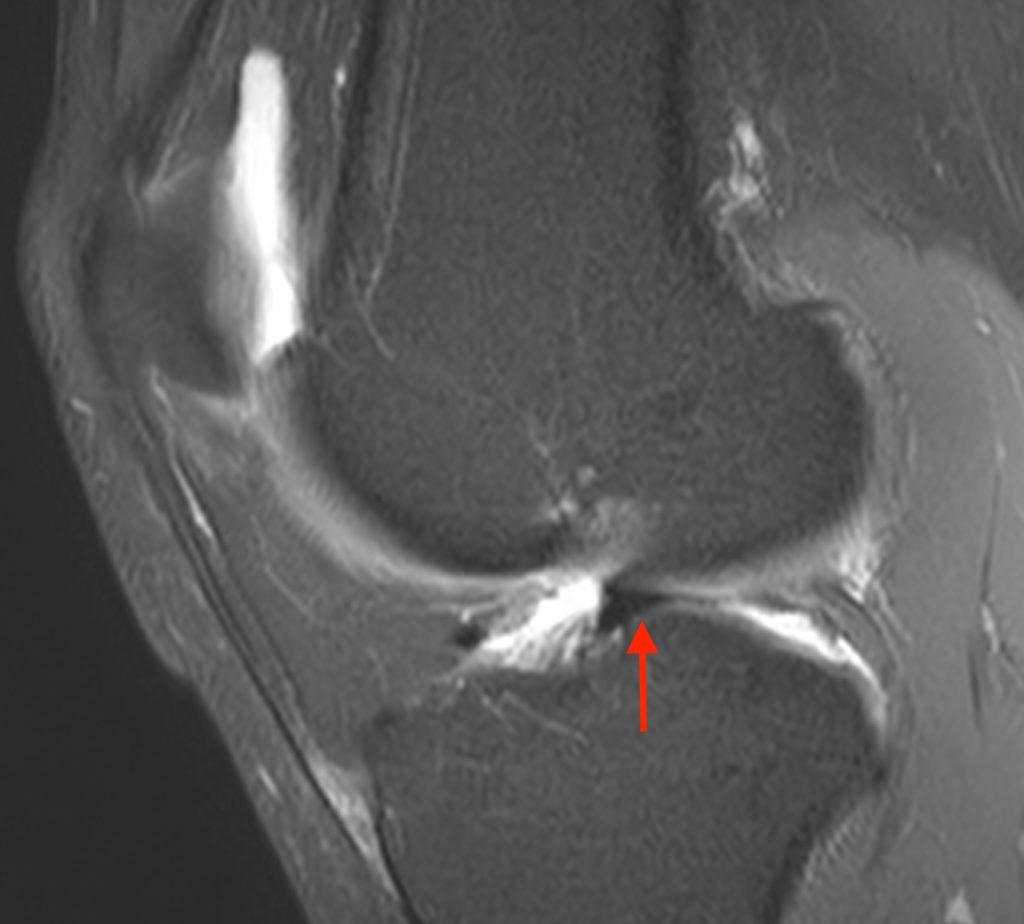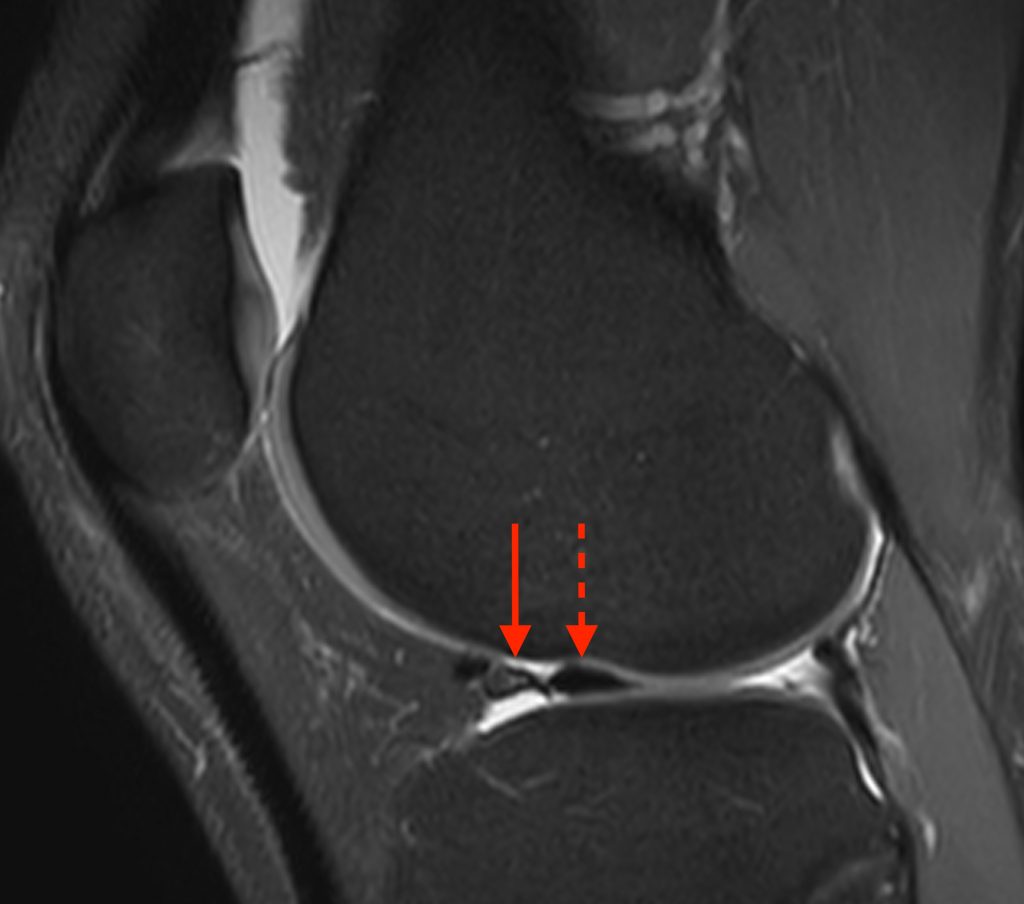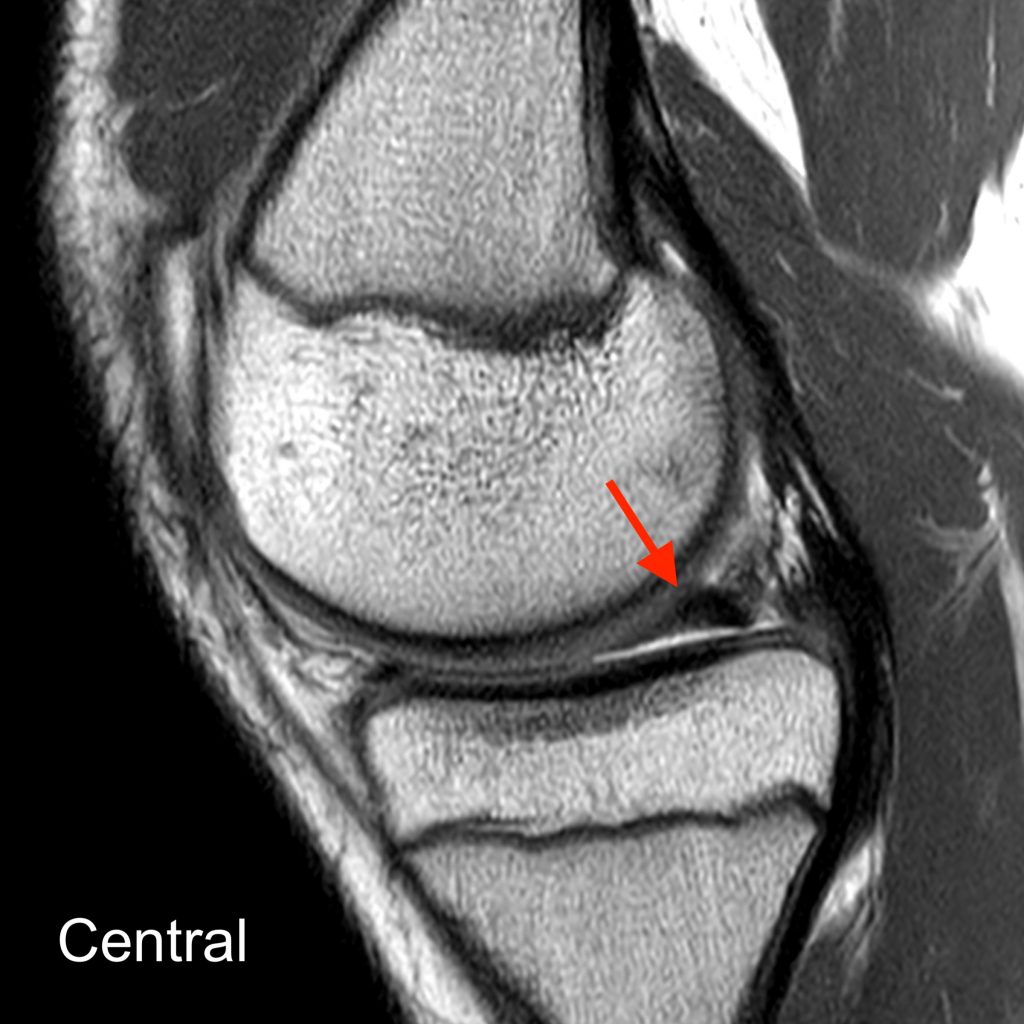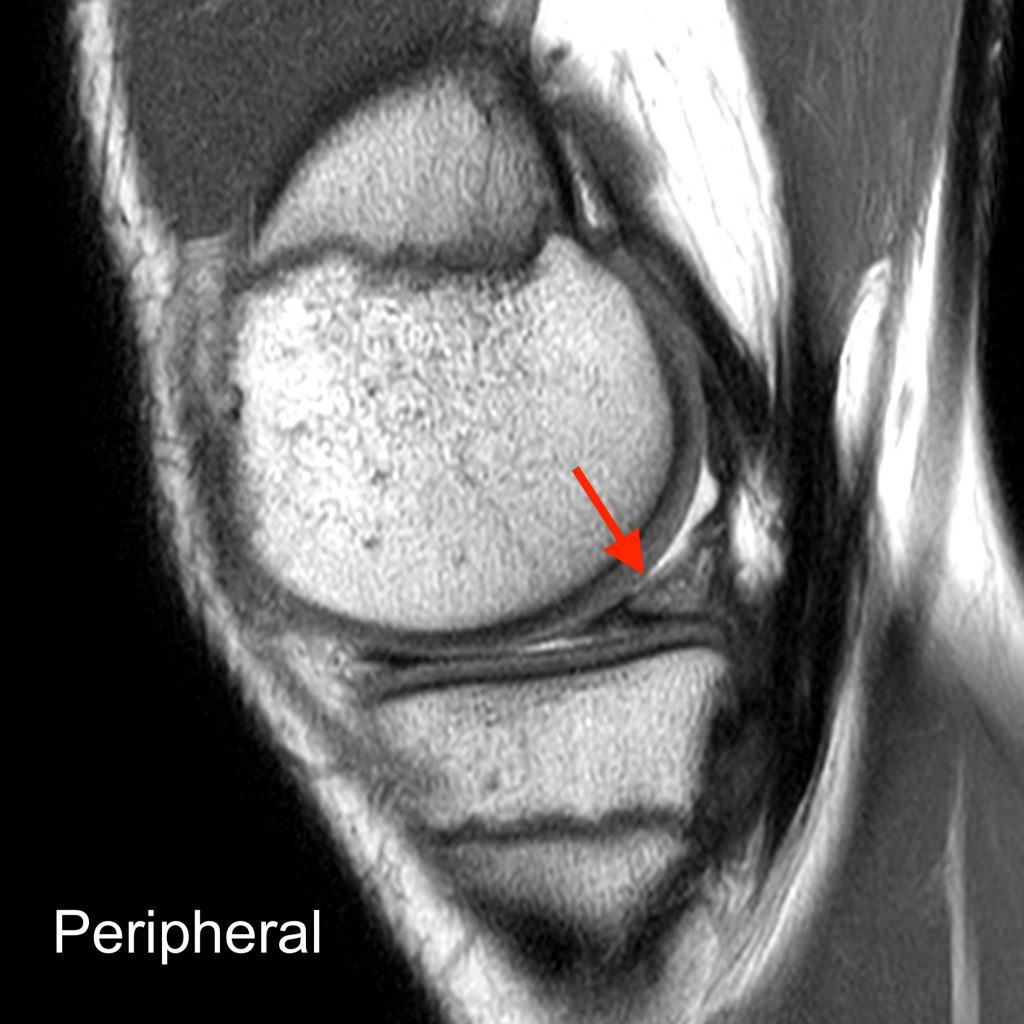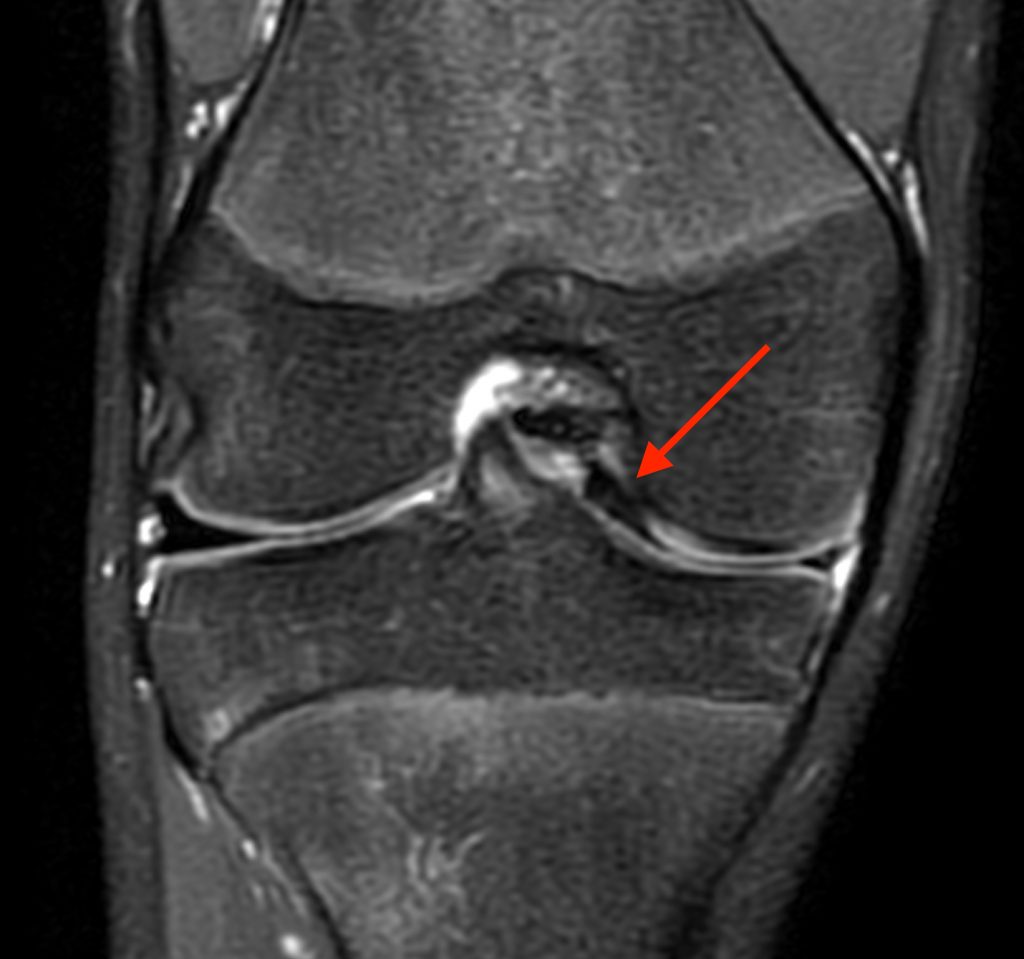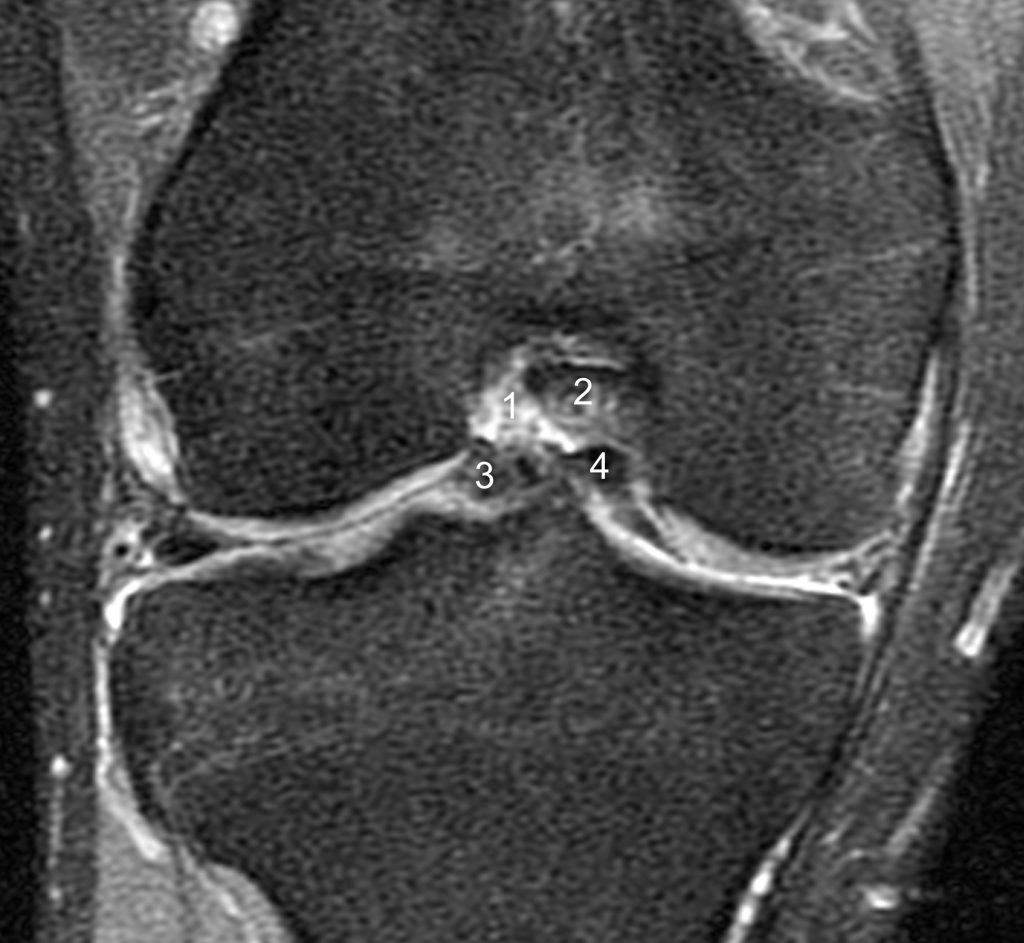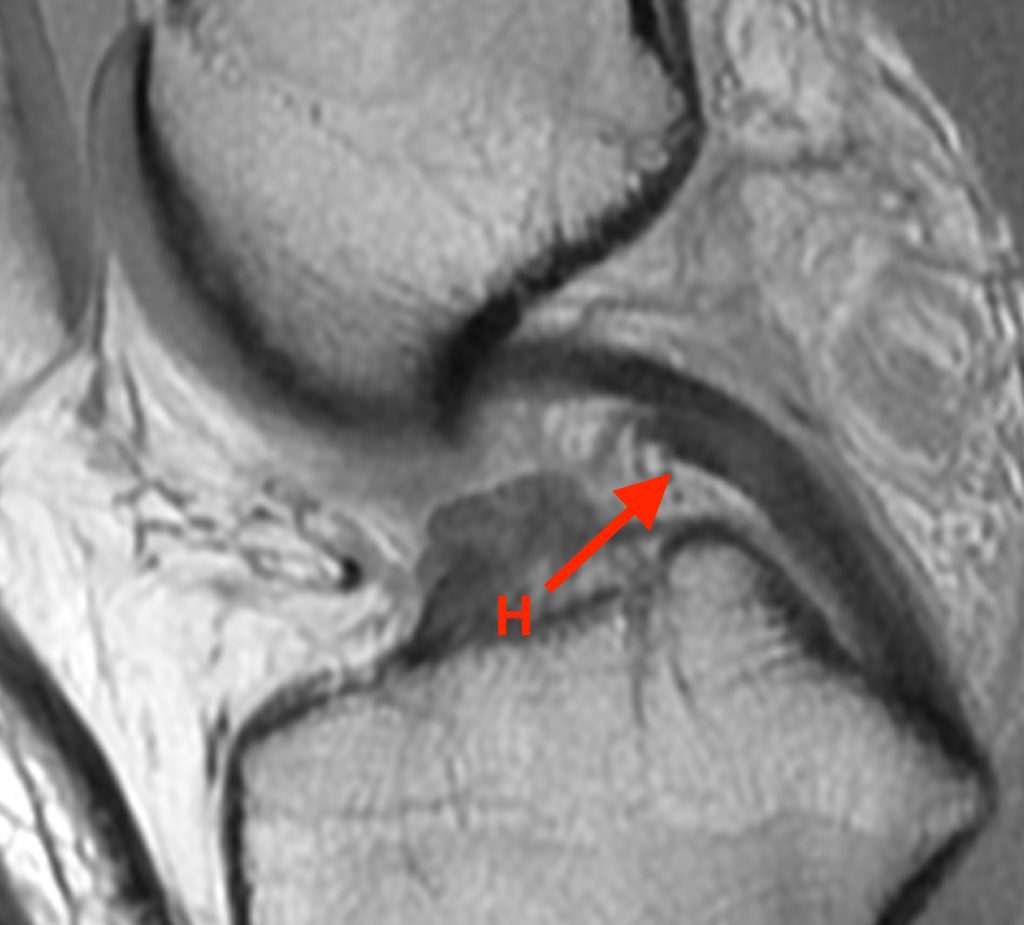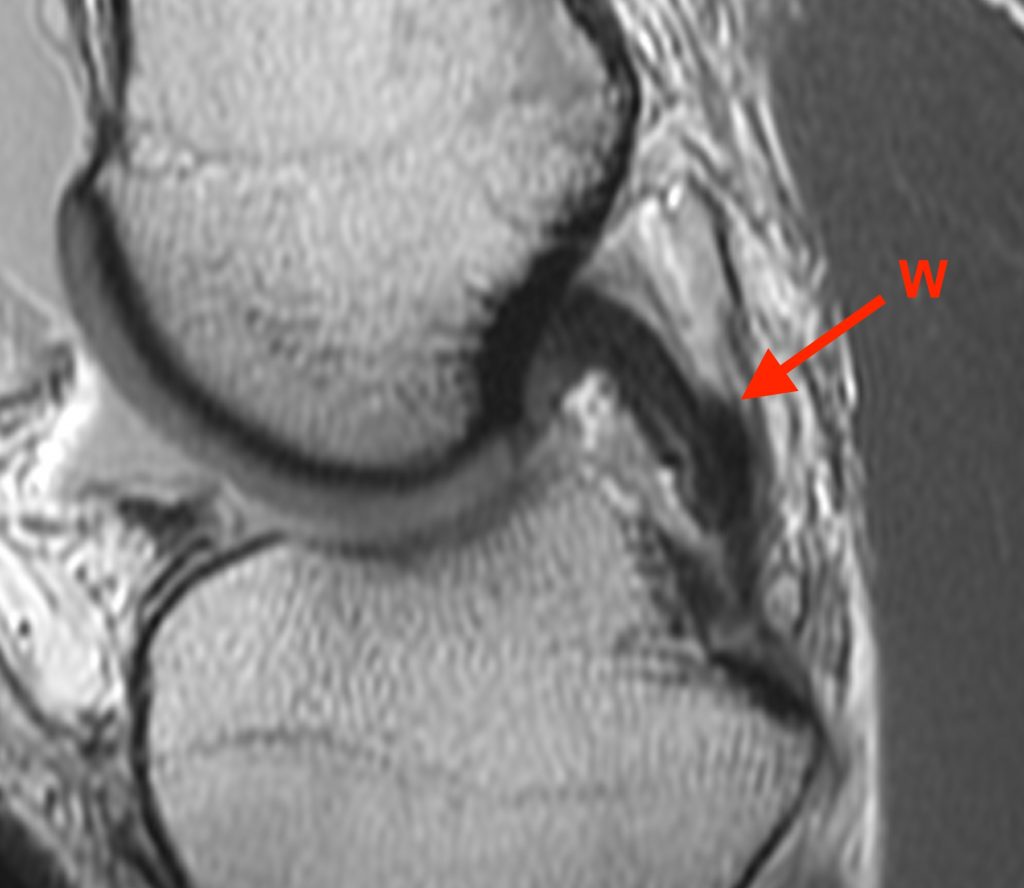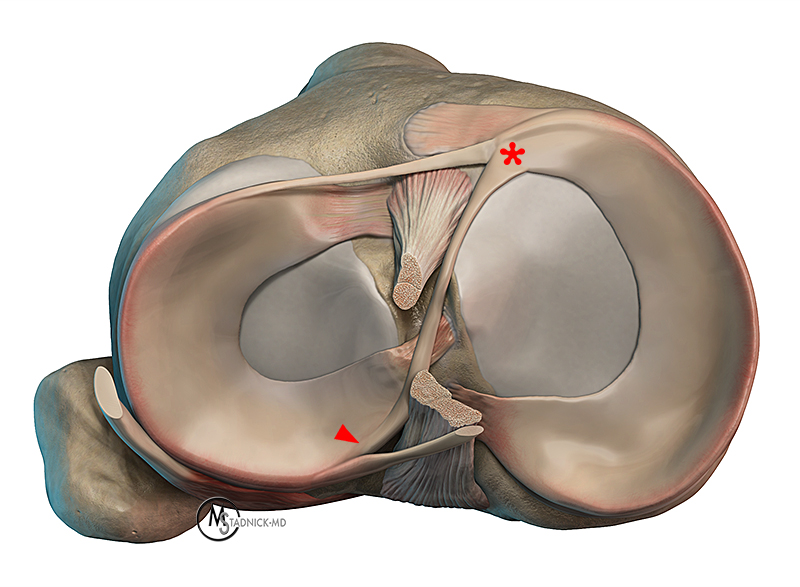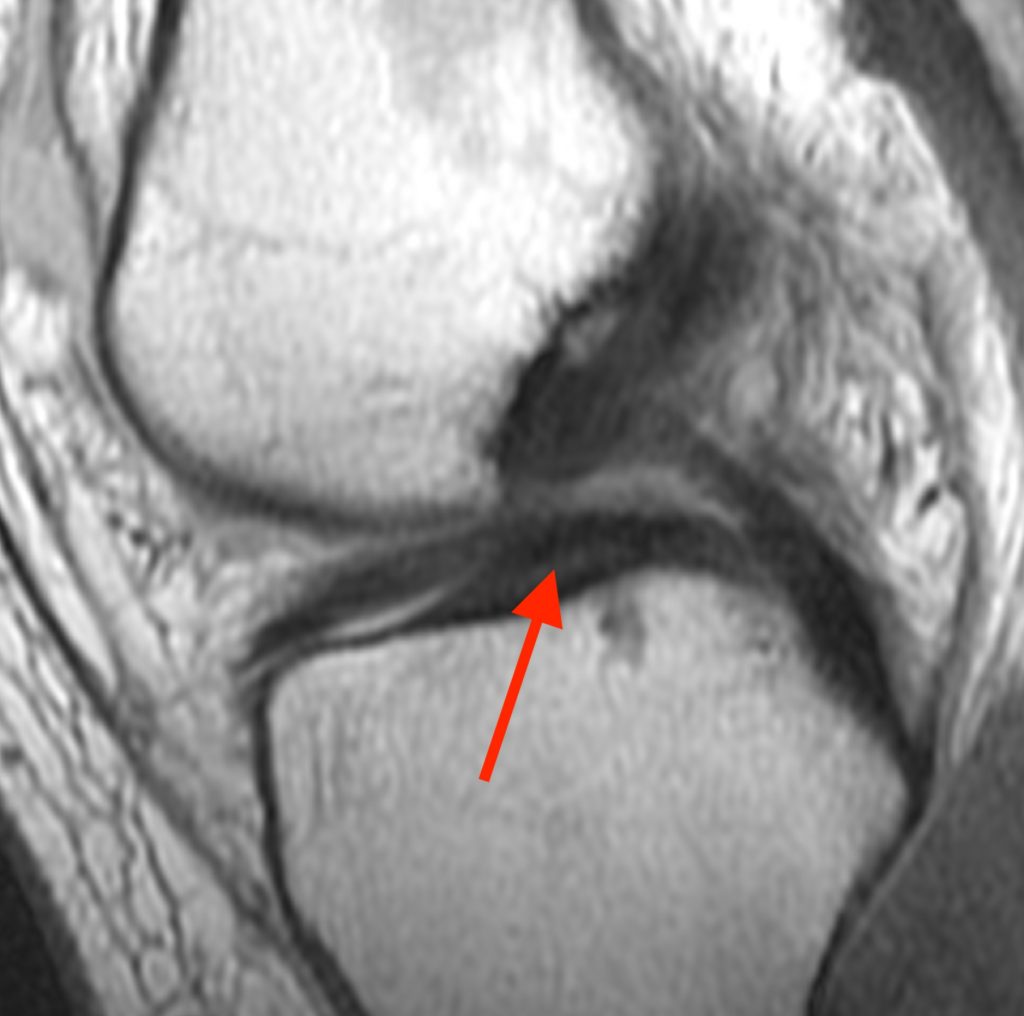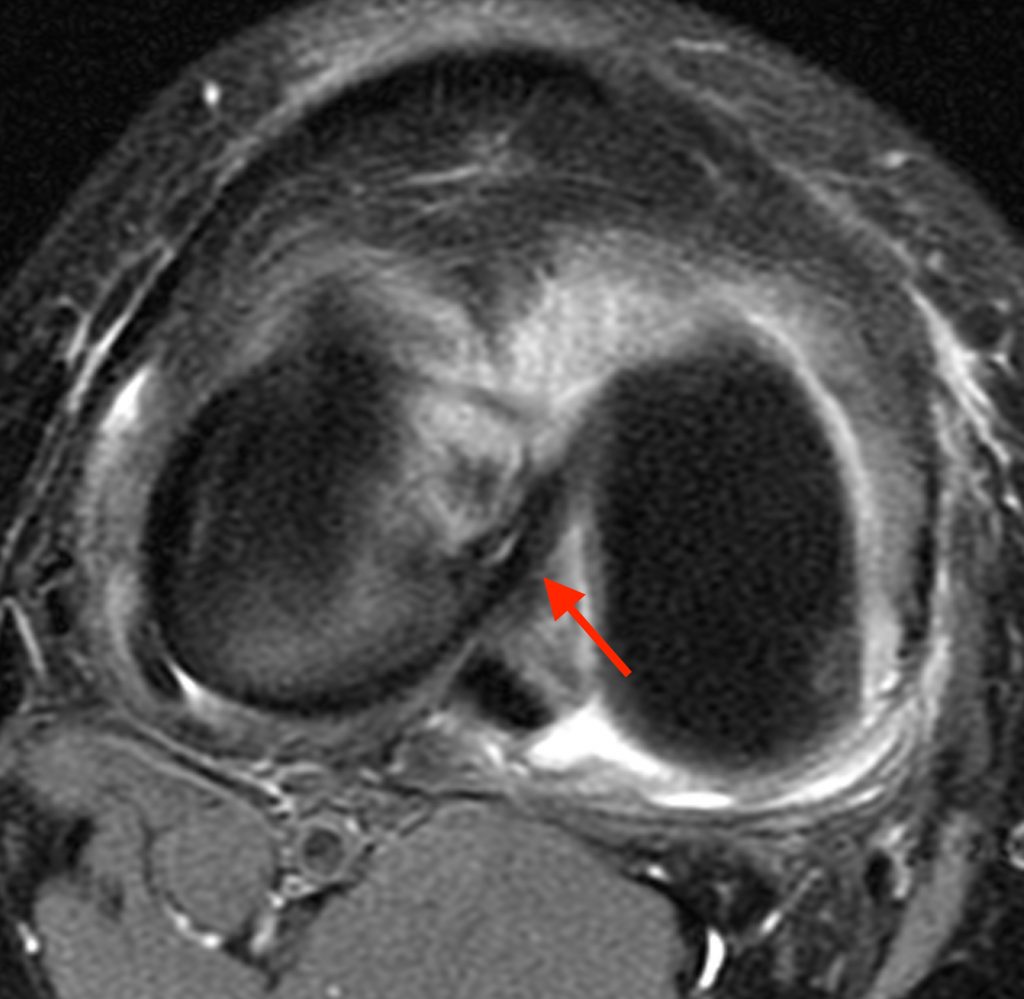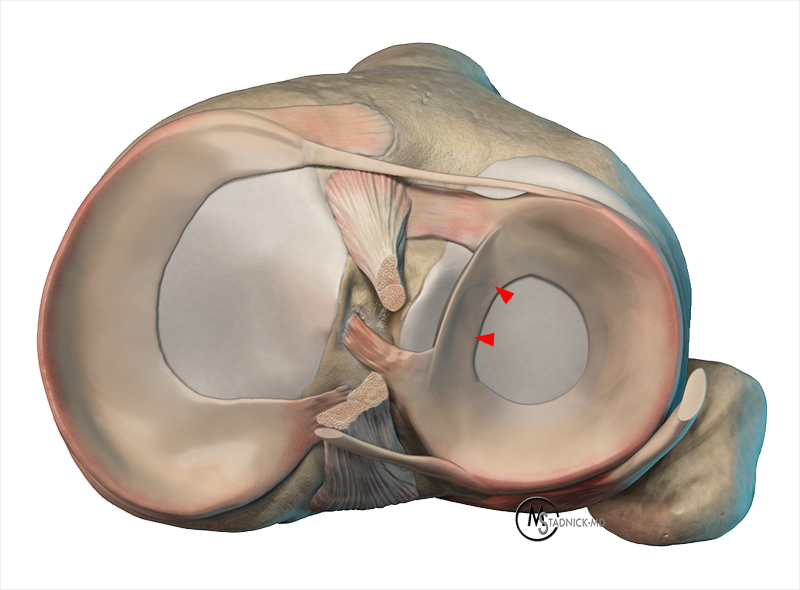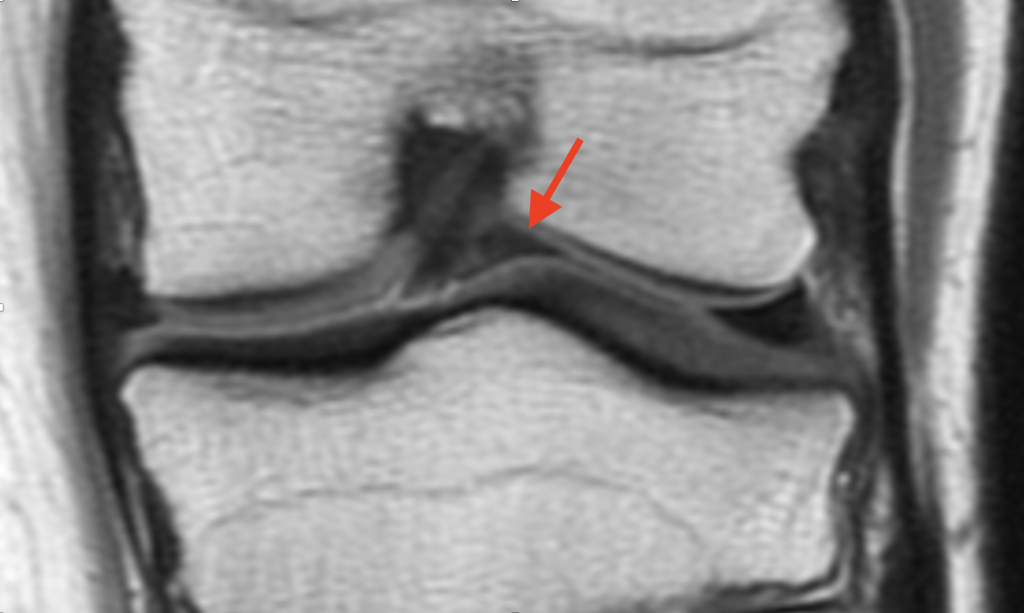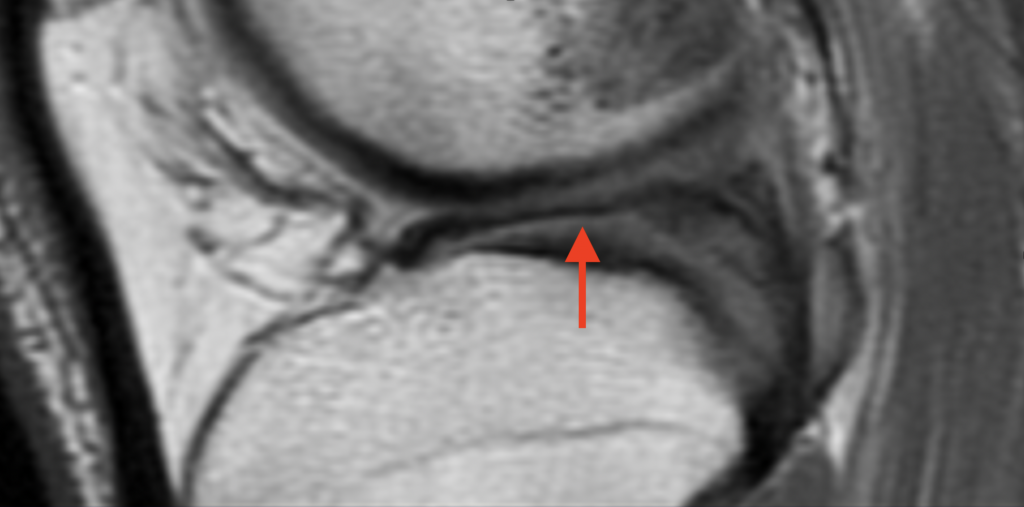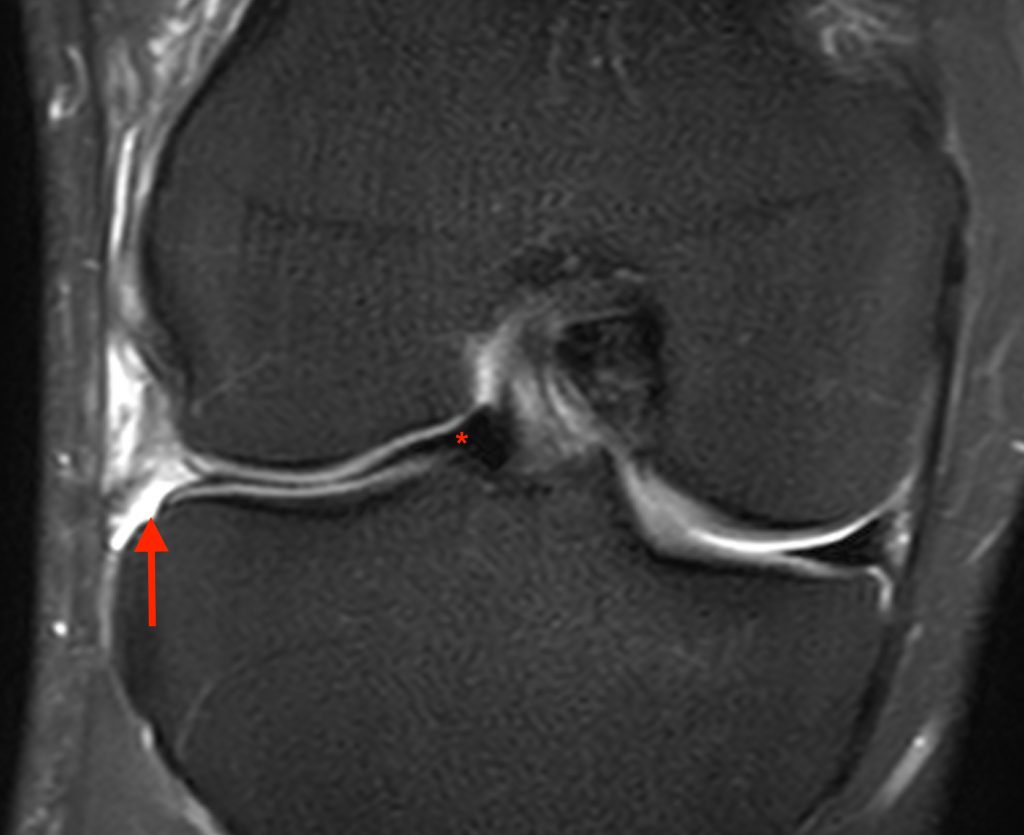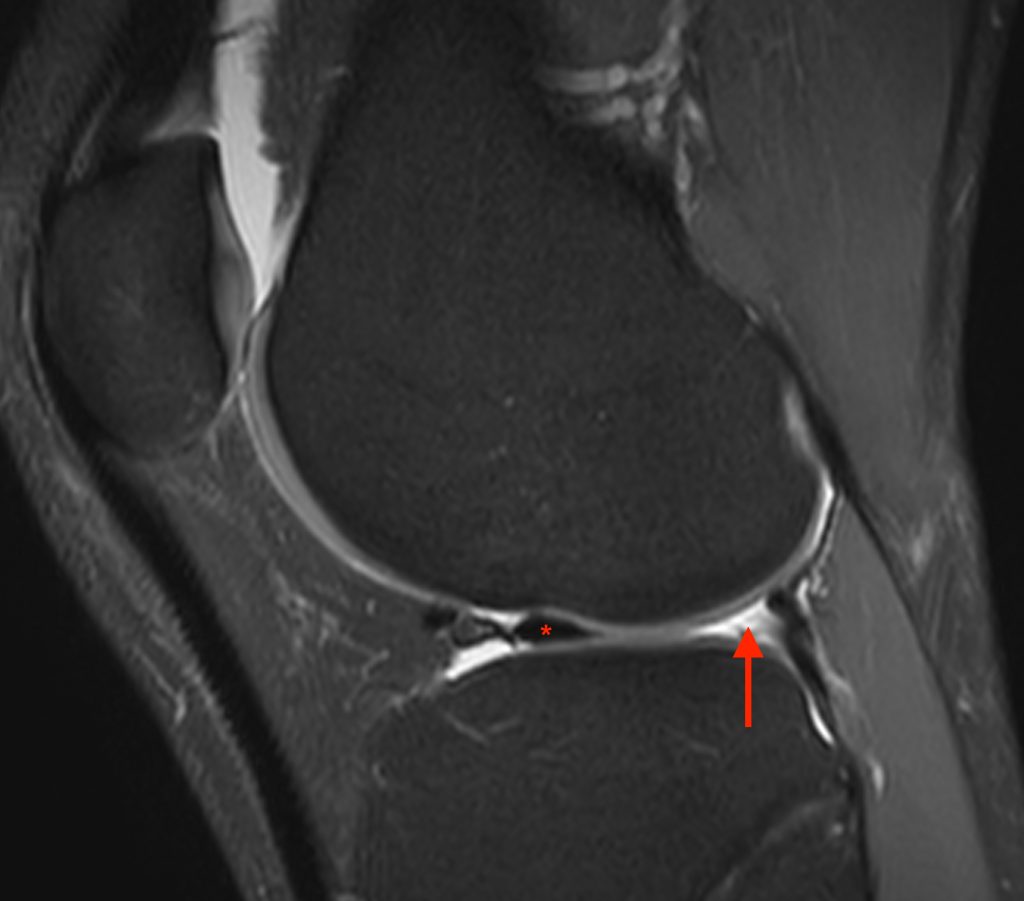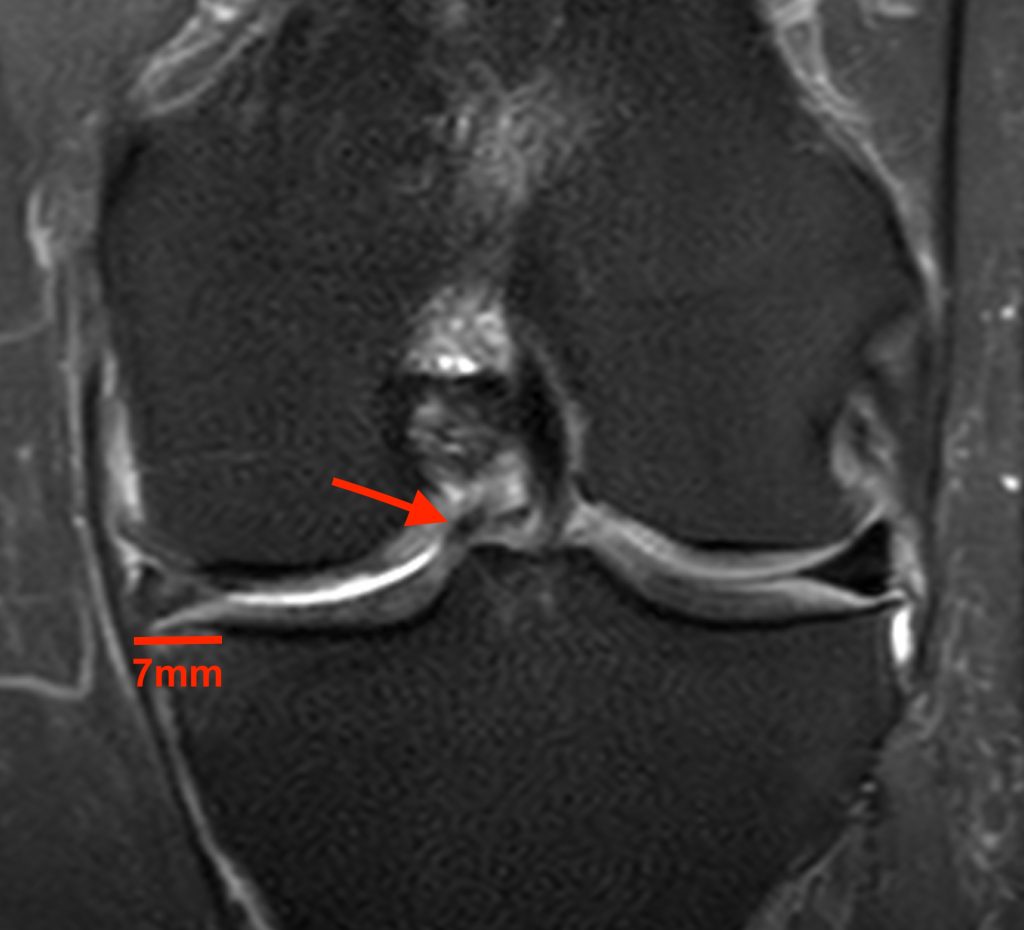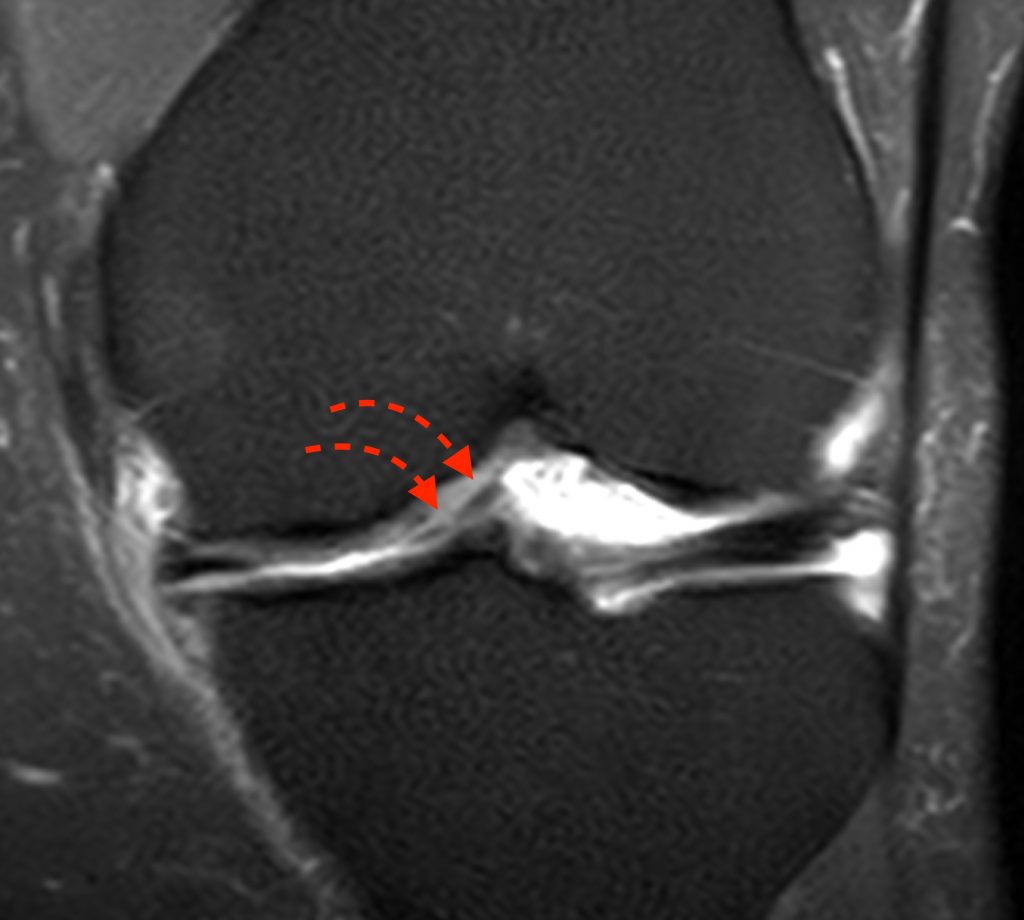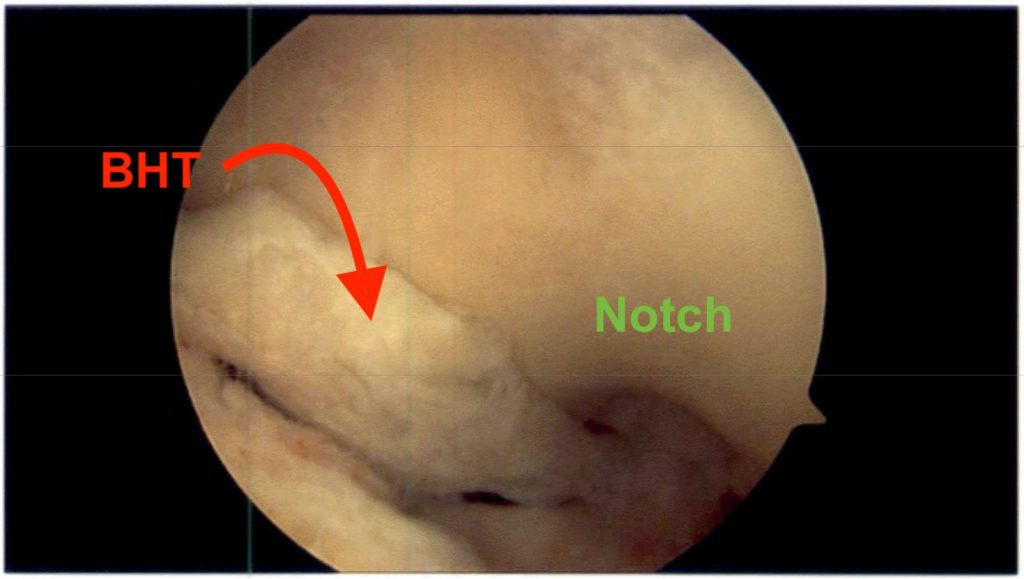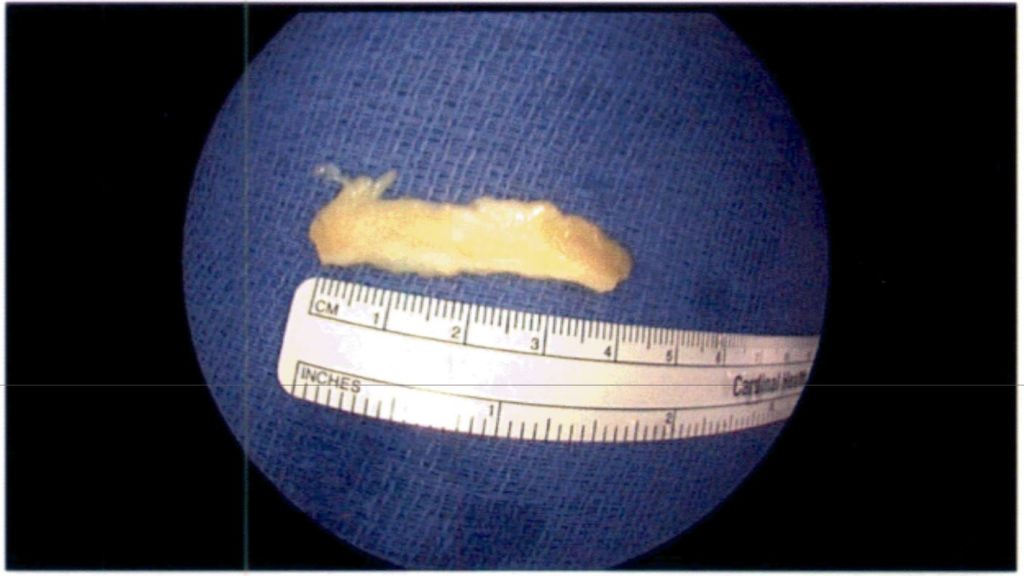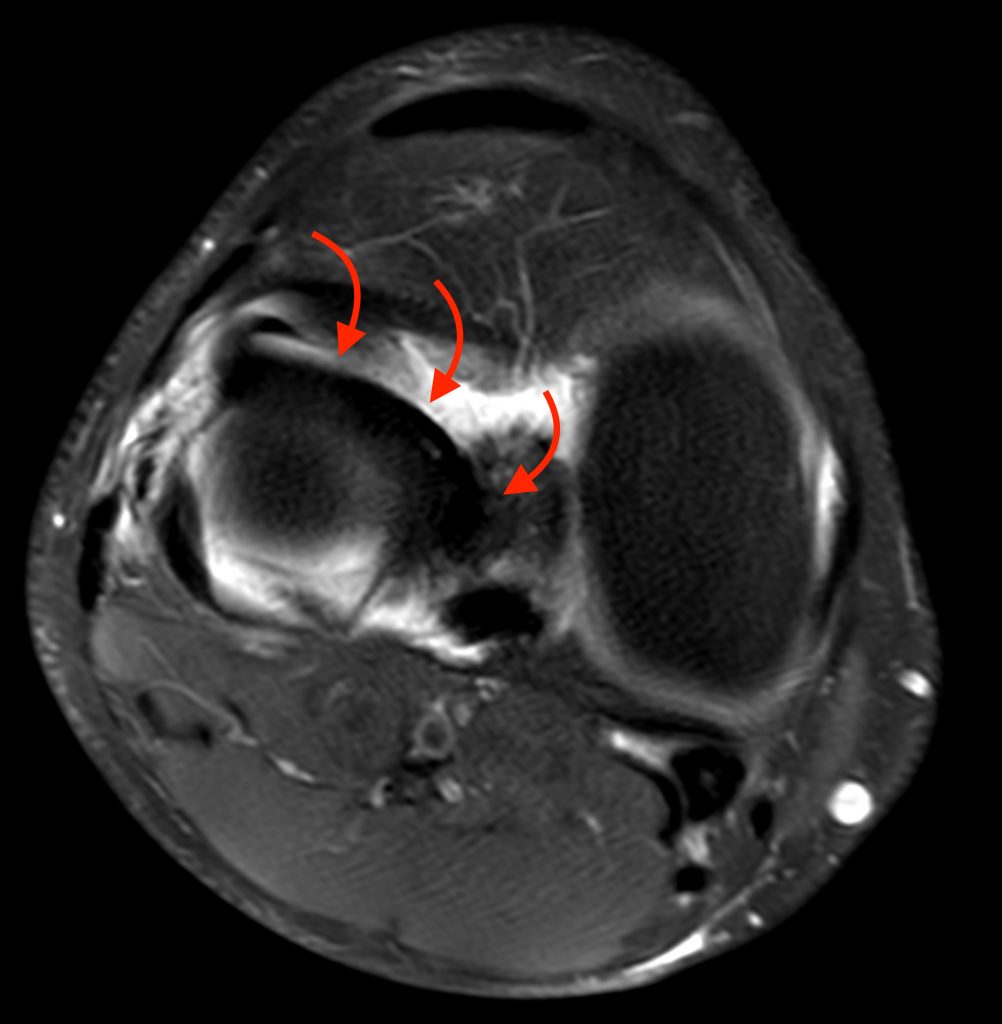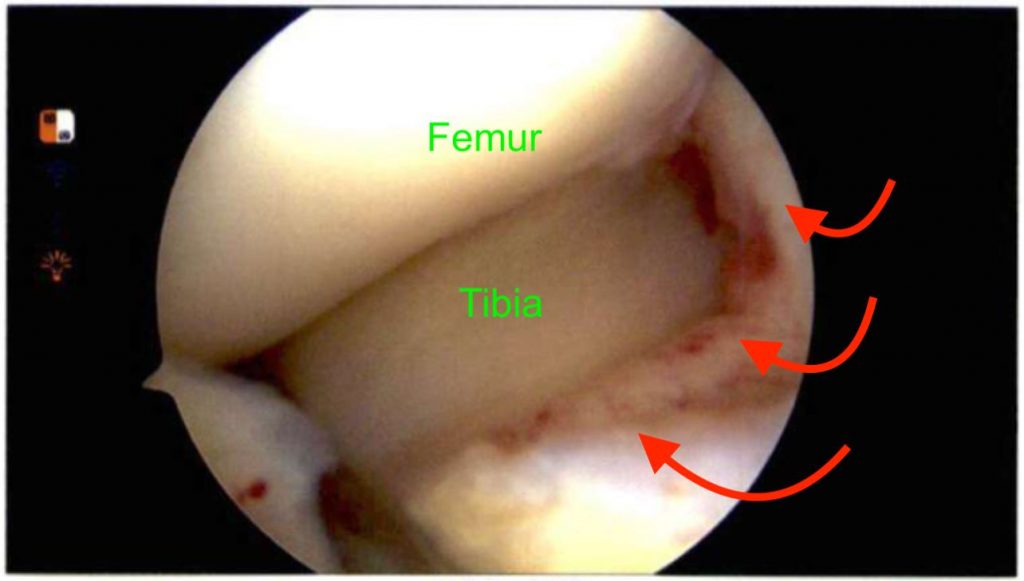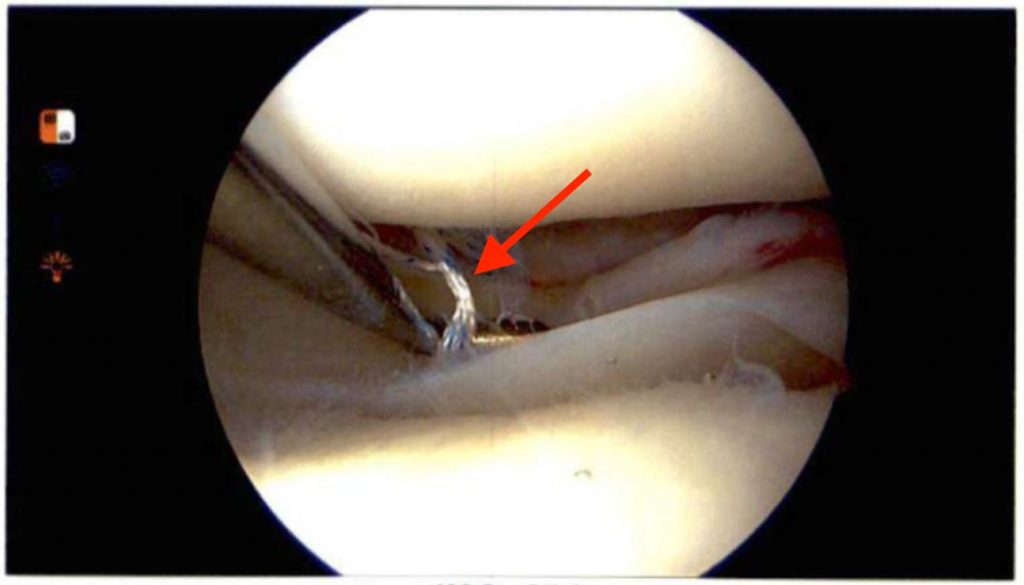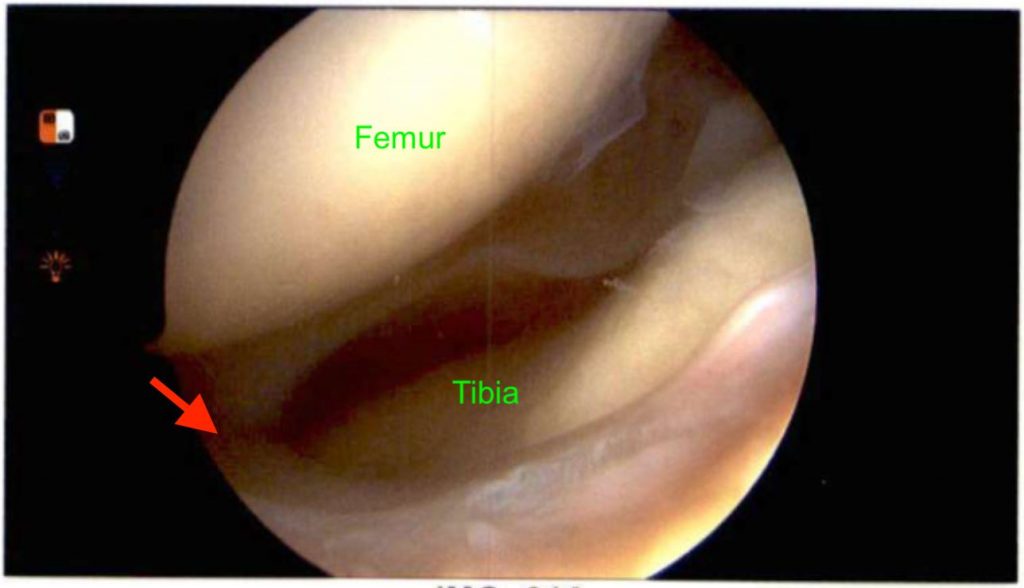Clinical History:
A 25 year-old male presents with medial knee pain after recent injury. Three contiguous sagittal fat-suppressed proton density-weighted images are provided. What are the findings? What MRI sign is demonstrated? What is your diagnosis?
Findings
Figure 2:
2a-c: Three contiguous sagittal fat-suppressed proton density-weighted images along the medial knee demonstrate abnormal linear horizontal oblique signal at the medial meniscus posterior body and adjacent posterior horn, communicating with the tibial surface (long arrow). Additionally, the medial meniscus body is thin in caliber, consistent with an “absent bow-tie” sign (short arrow).
2d: Sagittal fat-suppressed proton density-weighted image near the central knee demonstrates an irregular displaced bucket handle segment located within the intercondylar notch (arrows).
2e: Coronal fat-suppressed proton density-weighted image demonstrates a displaced bucket handle segment within the intercondylar notch (arrow) and a truncated appearance of the native body (asterisk).
2f: Axial fat-suppressed proton density-weighted image demonstrates the extent of the displaced bucket handle, flipped anterolaterally into the intercondylar notch (arrows).
Diagnosis
Bucket-handle tear of the medial meniscus.
Introduction
Bucket-handle tears are so named because the inner rim of the meniscus pulls away from the residual meniscal periphery, resulting in a longitudinal tear pattern that resembles the shape of a bucket. Bucket-handle tears are quite important clinically, as locking of the joint often occurs, necessitating arthroscopic treatment of the tear. Unfortunately, bucket-handle tears of the meniscus are one of the more frequently missed tear patterns with MR imaging.
Incidence, epidemiology, clinical symptoms
The frequency of bucket-handle meniscal tears has been reported between 9-26%, more commonly in young and middle-aged adults, with a 88% male predominance, and with an 76% predilection for the less mobile medial meniscus 1. An association between anterior cruciate ligament (ACL) ruptures and bucket-handle tears also exists, reported between 11-48%.1 In the acute setting, a bucket-handle tear may present with intermittent locking and an inability to fully extend the knee. In the chronic setting, a bucket-handle tear may scar into the intercondylar notch, remaining unreduced.2
Anatomy
In the normal meniscus, longitudinally oriented type 1 collagen bundles exist along the long-axis of the meniscus, providing hoop strength and preventing extrusion of the meniscal tissue away from the load-bearing tibiofemoral surfaces. Radially oriented tie fibers attach perpendicularly between the longitudinal bundles, thereby forming an interconnected lattice of structural support (Figure 3a-b). 3
When a tear dissects along the long axis of the meniscus, between the longitudinally oriented collagen bundles, the tear is termed a longitudinal tear (Figure 3b-c). Longitudinal tears separate the meniscus into central and peripheral segments, oriented perpendicular to the tibial plateau. Longitudinal tears tend to occur in younger patients, after significant trauma, and have a propensity to involve the periphery of the meniscus.3
A bucket-handle tear of the meniscus is a subtype of longitudinal tear, typically beginning in the posterior horn, extending longitudinally through the body and towards the anterior horn. The inner margin of torn meniscal tissue can often become displaced, extending towards the intercondylar notch, forming the so-called “bucket handle” (Figure 3e).
Figure 3:
Meniscal (Normal and Tear) Anatomy
3a-b: Longitudinally oriented collagen bundles are present along the long-axis of the meniscus, providing hoop strength. Radially oriented tie fibers attach perpendicularly between the longitudinal bundles, forming an interconnected lattice of structural support.
3c-d: Longitudinal tear, dissecting along the long axis of the meniscus, between the longitudinally oriented collagen bundles, separating the meniscus into central and peripheral segments.
3e: Bucket-handle tear subtype of longitudinal tear. The inner margin of the torn meniscus has displaced towards the intercondylar notch, thus forming the “bucket handle”.
In 1990, Dandy described the arthroscopic appearance of various meniscal tear patterns, occurring in both the medial and lateral meniscus.4 In the medial meniscus, 4 variations of bucket handle tears are described, all of which began at or near the posterior insertion (root), extending anteriorly. In the lateral meniscus, 6 bucket-handle tear variations are described. Longitudinal tears of the lateral meniscus begin at the posterior insertion and extend anteriorly to either the popliteus hiatus or the anterior insertion, but not ending between. Dandy also described various non-bucket handle tears in his classification, which are not included in this discussion.
According to Dandy’s classification of medial meniscal tears, a locked type I (complete) longitudinal tear extends the whole length of the meniscus to within 1 cm of the anterior insertion (Figure 4a). A locked type II (incomplete) longitudinal tear extends beyond the junction of the middle and anterior thirds, but not as far as the anterior root (Figure 4b). Some bucket-handle tears were noted to contain ruptured fragments and were divided based on the site of rupture and resultant fragment attachment. A detached anterior fragment ruptured from the posterior horn, with a long segment retaining attachment to the anterior horn (Figure 4c). A detached posterior fragment ruptured anteriorly, with a long segment retaining attachment to the posterior horn (Figure 4d). These fragments were often found lying in the posteromedial compartment.
According to Dandy’s classification of lateral meniscal longitudinal tears, whole-length, whole-width tears extend the full length of the meniscus at or near the periphery, leaving no stable bridge across the popliteus tendon (Figure 5a). Half-length, whole width tears begin at the posterior insertion, stopping at the popliteus hiatus, occupying the whole meniscal width (Figure 5b). Whole-length, half-width tears extend the full length of the meniscus, but do not include the whole width (Figure 5c). Half-length, half-width tears extend from the posterior insertion to the popliteus hiatus, involving only part of the meniscal width (Figure 5d). Ruptured fragments arising from longitudinal tears can be of variable shape and length and were not subdivided (Figure 5e). Anterior tags arise from vertical tears at the lateral meniscus anterior insertion, extending into a radial tear of the middle third, creating a right-angled tear tag (Figure 5f).
MRI Findings
At least 6 MRI signs of meniscal bucket handle tears have been described. The absent bow-tie sign described by Helms et al.5 requires 2 adjacent sagittal images to maintain a normal body segment appearance, resembling a “bow-tie”. A normal meniscal body averages 9-12 mm in width, therefore 4 mm images should reveal the body on two successive images (Figure 6a, Figures 6c-d). If a displaced bucket-handle tear is present, a portion of the meniscal body free edge should be deficient, with only one (or less) normal body slices seen on sagittal imaging (Figure 6b, 6e-f). The frequency of the absent bow-tie sign has been reported between 88.8 and 97%.1
Figure 6:
Absent Bow-Tie Sign
6a: Illustration of the normal meniscal body “bow-tie” appearance.
6b: Illustration of the abnormal “absent bow-tie” meniscal appearance with a bucket-handle tear.
6c-d: Two contiguous sagittal fat-suppressed proton density-weighted images demonstrate a normal bow tie appearance of the medial meniscus.
6e-f: Two contiguous sagittal fat-suppressed proton density-weighted images demonstrate an irregular truncated appearance of the medial meniscus body consistent with an “absent bow-tie” sign. Figure 6f also demonstrates abnormal linear increased signal within the adjacent posterior horn.
The double PCL sign was originally described by Weiss et al.6 and is a low signal intensity-band of tissue that resides parallel and anteroinferior to the posterior cruciate ligament (PCL) on sagittal imaging (Figure 7). The second (double) PCL is the displaced bucket-handle medial meniscal tissue within the intercondylar notch and the medial tibial eminence. The intact ACL serves as a barrier, preventing further lateral displacement of the meniscal segment. The double PCL sign specificity was reported at 98-100% and a positive predictive value of 93%.7
The flipped meniscus sign was described by Haramati et al.8 and is present when tissue containing a well-defined meniscal shape is located immediately posterior to the anterior horn, seen in conjunction with a shortened posterior horn9 (figure 8). A meniscal fragment within the intercondylar notch sign is described as a bandlike area of low signal tissue within the notch, but not appearing on the same slice as the PCL 9 (figure 9). These two signs can be seen in both medial and lateral bucket-handle meniscal tears, whereas the double PCL sign is only seen in medial bucket-handle tears. The frequency of the flipped meniscus sign has been reported at 25%, and the fragment within the intercondylar notch sign has been reported between 51 and 93%.1
The double anterior horn sign was described by Ruff et al.10 as two adjacent triangular seemingly anterior horns on a sagittal image. The anterior triangle represents the normal anterior horn, while the posterior triangle represents the displaced bucket handle segment (figure 10). This is similar to the flipped meniscus sign but differentiated by the visualization of two separate anterior meniscal entities rather than a single large entity. The frequency of this sign has been reported between 29 and 33%.1
Figure 10:
Double Anterior Horn Sign
Sagittal fat-suppressed proton density-weighted image demonstrates two adjacent apparent triangular anterior horns. The anterior triangle represents the normal anterior horn (arrow), while the posterior triangle represents the displaced bucket handle segment (dashed arrow).
The disproportional posterior horn sign was described by Chen et al.11 as supportive criterion to identify a posterocentrally displaced meniscal segment. If the meniscal posterior horn in the central portion appears larger than that in the peripheral section, it is considered a positive disproportional posterior horn sign (figure 11). The frequency of this sign has been reported between 21 and 27.7%.1
Figure 11:
Disproportional Posterior Horn Sign
Sagittal proton density-weighted image of the meniscal posterior horn closer to the central knee (11a, arrow) appears larger than that of a more peripheral image (11b arrow), consistent with a positive “disproportional posterior horn sign”, supportive criterion of a posterocentrally displaced meniscal segment.
11c is a coronal fat-suppressed proton density-weighted image confirming the displaced bucket handle segment extending towards the intercondylar notch.
MRI is a proven accurate method to non-invasively diagnose bucket handle meniscal tears, particularly when more than one of these signs are present.12 The absent bow tie sign has a reported sensitivity of 88%. The presence of a displaced fragment sign has a reported sensitivity of 90.7%. The combination of an absent bow-tie sign and displaced fragment sign has a specificity of 85.7%. The double PCL sign specificity has been reported as 100%. The anterior flipped meniscus sign specificity is reported at 89.7%.
Simultaneous bucket handle tears of both the medial and lateral menisci can also occur, more commonly with tears of the ACL and presumably related to increased instability of the knee.13 Without an intact ACL, forces transmitted through the medial meniscus have been reported to increase 197% at 60 degrees of flexion.14 The appearance of the four structures in the intercondylar notch (two meniscal fragments, ACL, and PCL) on the coronal images has been described with bicompartmental meniscal tears and called the “quadruple cruciate sign”15 (figure 12).
Figure 12:
Quadruple Cruciate Sign
Coronal fat-suppressed proton density-weighted image demonstrates four structures in the intercondylar notch, consistent with the “quadruple cruciate sign”, indicative of bicompartmental bucket handle tears. 1 = anterior cruciate ligament (torn in this case), 2 = posterior cruciate ligament, 3 = displaced lateral meniscus bucket handle, 4 = displaced medial meniscus bucket handle.
Pitfalls and Differential Diagnosis
Normal structures and normal anatomic variants are potential pitfalls in diagnosing bucket-handle meniscal tears. The most commonly seen are the normal meniscofemoral ligaments, which arise from the posterior horn of the lateral meniscus and attach to the lateral aspect of the medial femoral condyle. On sagittal imaging, these lie adjacent to the PCL and can be confused for a double PCL sign. A ligament of Humphrey (figure 13a) is located anterior to the PCL, while the ligament of Wrisberg lies posterior to the PCL (figure 13b).
Figure 13:
Meniscofemoral ligaments
13a: Intersecting bandlike low signal along the anterior aspect of the PCL (arrow), representing a normal ligament of Humphrey, which can mimic the double PCL sign.
13b: Intersecting bandlike low signal along the posterior aspect of the PCL (arrow), representing a normal ligament of Wrisberg.
An oblique meniscomeniscal ligament (figure 14) is an anatomic variation extending from either the anterior horn of the medial meniscus to the posterior horn of the lateral meniscus (medial oblique meniscomeniscal ligament), or from the anterior horn of the lateral meniscus to the posterior horn of the medial meniscus (lateral oblique meniscomeniscal ligament).16 Because these anatomic variations course through the intercondylar notch, they may also be confused with bucket handle meniscal tears. Differentiation can be made by following the course and identifying the bicompartmental oblique meniscal attachments, as well as recognizing normal morphology of the meniscal bodies.
Figure 14:
Oblique meniscomeniscal ligament
14a: Illustration demonstrating a medial oblique meniscomeniscal ligament (arrows) coursing from the lateral meniscus posterior horn (arrowhead), through the intercondylar notch, to the medial meniscus anterior horn (*).
14b: Sagittal proton density-weighted image demonstrates an oblique meniscomeniscal ligament anteroinferior to the PCL (arrow).
14c: Axial fat suppressed proton density-weighted image demonstrates a medial oblique meniscomeniscal ligament (arrow) coursing from the lateral meniscus posterior horn, through the intercondylar notch, to the medial meniscus anterior horn.
A ring meniscus is a rare anatomical variant in which a low signal intermeniscal bridge is present between the anterior and posterior meniscal horns, forming a complete ring17 (figure 15a). These typically occur in the lateral meniscus but rare reports of medial rings are also reported.17 On coronal imaging, the intermeniscal bridge can appear as a mirror image of the body segment (“mirror-image” sign) (figure 15b)18 This should be smooth and triangular, whereas a bucket-handle tear will typically demonstrate frayed and truncated meniscal components of varying size. On sagittal imaging, the intermeniscal bridge appears as a smooth “bow-tie” on two consecutive slices, similar to the normal bow-tie appearance of the peripheral meniscus, described as the “central-bow tie sign” (figure 15c).18
Figure 15:
Ring Meniscus
15a: Illustration demonstrating a lateral ring-shaped meniscus with an intermeniscal bridge between the anterior and posterior horns of the meniscus.
15b: Coronal proton density-weighted image demonstrates a triangular intermeniscal bridge (arrow), appearing as a “mirror-image” of the lateral meniscus body.
15c: Sagittal proton density-weighted MRI demonstrating the “central bow tie sign” in a patient with a lateral ring- shaped meniscus.
(Case courtesy of Evelyne Fliszar, MD and Donald Resnick, MD, University of California San Diego)
MRI Assessment of Repairability
The menisci are vascularized from geniculate artery branches, entering the peripheral portion of the menisci. In the adult knee, only the peripheral third of the meniscus is vascularized (also known as the “red-zone”) while the inner two-thirds are avascular (“white-zone”). Therefore, peripheral tears that lie closer to the meniscosynovial junction are more likely to be located within a vascularized territory, increasing their chances of healing or being successfully treated with a primary meniscal repair rather than meniscectomy. The ideal tear is an acute longitudinal tear in the peripheral third of the meniscus, in a young patient with either a stable knee or who will undergo a concomitant ACL reconstruction.19
According to Thoreux et al.20, a bucket-handle tear is considered repairable when it meets all of the following MRI criteria:
- Peripheral rim segment less than 4 mm wide
- Tear length of 1 cm or greater, regardless of total lesion length
- Minimal damage to the inner and peripheral meniscal fragments
The peripheral rim segment is measured on coronal images for assessment of the body, and on sagittal images for assessment of the posterior horn. The length of the bucket-handle tear is an indication of its instability. The inner and peripheral meniscal tear components should contain normal low signal, excluding the presence of meniscal degeneration or multidirectional complex tearing.
Figure 16:
Repairable Meniscus
Fat-suppressed coronal (16a) and sagittal (16b) proton density-weighted images demonstrate a displaced bucket-handle lateral meniscal tear (*) with a very thin peripheral rim (arrow), greater than 1 cm in length, with minimal damage to the meniscal fragments, consistent with a repairable tear.
Figure 17:
Irreparable Meniscus
17a-b: Fat-suppressed coronal proton density-weighted images demonstrates a displaced bucket-handle tear located within the intercondylar notch (arrow). The body remnant is irregular and measures 7mm in transverse diameter, indicating the tear has occurred through the avascular meniscal “white zone”. The displaced bucket-handle tear is also irregular (dashed arrows). The tear location and irregularity make this an unfavorable meniscal repair candidate.
17c: Arthroscopic image of the same patient confirms the irregular displaced bucket-handle tear (BHT) within the intercondylar notch.
17d: Arthroscopic image demonstrates the resected meniscal tissue, after a partial meniscectomy.
Arthroscopy images courtesy of David Moore, MD (Elite Sports Medicine and orthopaedics, Nashville, TN)
Surgical Repair Techniques 21,22
Several primary meniscal repair techniques exist. The most performed is the “all-inside” technique whereby the meniscus is repaired all-arthroscopically, typically using pledgeted sutures. This technique has grown in popularity with the advent of newer devices allowing repair through small arthroscopy portals. Other techniques, requiring larger incisions, involve the passage of a needle through the meniscus and are named based on the direction of the needle placement (“inside-out”, “outside-in”). While these techniques can allow for greater precision, they also require greater surgical exposure.
With the “inside-out” technique, a needle is passed from inside the joint, through the torn meniscus, outside of the capsule where sutures are tied. The “inside-out” technique is traditionally considered the gold standard, useful for large/complex tears (such as a displaced bucket-handle tear), allows the ability to place more sutures, and with precise placement potentially less damaging to the meniscus.
An “outside-in” technique may also be performed, inserting a needle from outside of the joint, through the meniscal tear, into the joint, and is most commonly used for anterior horn and anterior body repairs. If a bucket-handle meniscal tear extends far anteriorly, an “inside-out” or “outside-in” repair may be used to fix the most anterior portion.
Figure 18:
Meniscal Repair
18a: Fat-suppressed axial proton density-weighted image demonstrates a displaced lateral bucket-handle tear located within the intercondylar notch (arrows).
18b: Arthroscopic image of the same patient confirming the displaced bucket-handle tear (arrows).
18c: Arthroscopic image demonstrates the suture placement (arrow) during an all-inside primary meniscal repair.
18d: Arthroscopic imaged following meniscal repair demonstrates a normal reduced appearance of the repaired lateral meniscus (arrow).
Arthroscopy images courtesy of David Moore, MD (Elite Sports Medicine and orthopaedics, Nashville, TN)
Bucket-handle tear primary repair surgical outcomes have a high success rate, particularly with a competent ACL. In a second look arthroscopy study by Feng et al.23, the bucket-handle tear repair success rate was reported as 89.6% with healing occurring after an average of 26 months. Following bucket-handle tear repair, MRI can also effectively evaluate the postoperative meniscus.
Summary
MRI can be used effectively to both diagnose and determine the repairability of bucket-handle meniscal tears. Several MRI signs have been described and accuracy is improved with the presence of multiple signs. Accuracy can also be improved with knowledge of bucket-handle tear mimics and variant meniscal anatomy. Primary surgical repair of bucket-handle tears has favorable outcomes, particularly in peripheral tears at least 1 cm in length, with minimal damage to the inner and outer torn segments. MRI provides valuable guidance as to whether a bucket handle tear is repairable.
Bibliography
- Ververidis AN, Verettas DA, Kazakos KJ, Tilkeridis CE, Chatzipapas CN. Meniscal bucket handle tears: A retrospective study of arthroscopy and the relation to MRI. Knee Surgery, Sport Traumatol Arthrosc. 2006;14(4):343-349. doi:10.1007/s00167-005-0678-x ↩
- Wheeless CR. Bucket Handle Meniscus Tear. Howard J. Luks, MD blog. http://www.howardluksmd.com/knee-common-injuries/meniscus-knee/bucket-handle-meniscus-tear/. Published 2016. ↩
- Smet AA De, Graf BK, Rosas HG. Diagnosis and Classification of Meniscal Tears – MRI. Radiographics. 2014;(1). meniscus; knee; classification; meniscal tear. ↩
- Dandy DJ. The arthroscopic anatomy of symptomatic meniscal lesions. J Bone Jt Surg – Ser B. 1990;72(4):628-633. doi:10.1302/0301-620x.72b4.2380218 ↩
- Helms CA, Laorr A, Cannon WD. The absent bow tie sign in bucket-handle tears of the menisci in the knee. Am J Roentgenol. 1998. doi:10.2214/ajr.170.1.9423600 ↩
- Weiss KL, Morehouse HT, Levy IM. Sagittal MR images of the knee: A low-signal band parallel to the posterior cruciate ligament caused by a displaced bucket-handle tear. Am J Roentgenol. 1991;156(1):117-119. doi:10.2214/ajr.156.1.1898543 ↩
- Camacho MA. The double posterior cruciate ligament sign. Radiology. 2004. doi:10.1148/radiol.2332020945 ↩
- Haramati N, Staron RB, Rubin S, Shreck EH, Feldman F, JKiernan H. The flipped meniscus sign. Skeletal Radiol. 1993;22(4):273-277. doi:10.1007/BF00197673 ↩
- Wright DH, De Smet AA, Norris M. Bucket-handle tears of the medial and lateral menisci of the knee: Value of MR imaging in detecting displaced fragments. Am J Roentgenol. 1995;165(3):621-625. doi:10.2214/ajr.165.3.7645481 ↩
- Ruff C, Weingardt JP, Russ PD, Kilcoyne RF. Pictorial essay. MR imaging patterns of displaced meniscus injuries of the knee. Am J Roentgenol. 1998;170(1):63-67. doi:10.2214/ajr.170.1.9423601 ↩
- Chen HC, Hsu CY, Shih TTF, Huang KM, Li YW. MR imaging of displaced meniscal tears of the knee: Importance of a “disproportional posterior horn sign.” Acta radiol. 2001;42(4):417-421. doi:10.1080/028418501127346918 ↩
- Dorsay TA, Helms CA. Bucket-handle meniscal tears of the knee: Sensitivity and specificity of MRI signs. Skeletal Radiol. 2003;32(5):266-272. doi:10.1007/s00256-002-0617-6 ↩
- Wright J, Tamura C, Findlay I, Daneshfar A. Simultaneous bicompartmental bucket handle meniscal tears with a clinically competent Anterior Cruciate Ligament. J Orthop Surg Res. 2010;5(1):2-4. doi:10.1186/1749-799X-5-68 ↩
- Allen CR, Wong EK, Livesay GA, Sakane M, Fu FH, Woo SLY. Importance of the medial meniscus in the anterior cruciate ligament-deficient knee. J Orthop Res. 2000. doi:10.1002/jor.1100180116 ↩
- Bugnone AN, Ramnath RR, Davis SB, Sedaros R. The quadruple cruciate sign of simultaneous bicompartmental medial and lateral bucket-handle meniscal tears. Skeletal Radiol. 2005;34(11):740-744. doi:10.1007/s00256-005-0915-x ↩
- Venkatanarasimha N, Kamath A, Mukherjee K, Kamath S. Potential pitfalls of a double PCL sign. Skeletal Radiol. 2009;38(8):735-739. doi:10.1007/s00256-009-0654-5 ↩
- Iqbal A, McLoughlin E, Botchu R, James SL. The ring-shaped meniscus: a case series demonstrating the variation of imaging appearances on MRI. Skeletal Radiol. 2020. doi:10.1007/s00256-019-03277-y ↩
- Koukoulias NE, Papastergiou SG. Symptomatic ring-shaped lateral meniscus. MRI findings. BMJ Case Rep. 2011. doi:10.1136/bcr.10.2011.4914 ↩
- Rodeo SA. Arthroscopic meniscal repair with use of the outside-in technique. J Bone Jt Surg – Ser A. 2000;82(1):127-141. doi:10.2106/00004623-200001000-00016 ↩
- Thoreux P, Réty F, Nourissat G, et al. Bucket-Handle Meniscal Lesions: Magnetic Resonance Imaging Criteria for Reparability. Arthrosc – J Arthrosc Relat Surg. 2006;22(9):954-961. doi:10.1016/j.arthro.2006.04.111 ↩
- Bonner, Kevin Jordan-Young Institute, Virginia Beach V. Inside-Out, Outside-In & All-Inside Meniscus Repair: Keep Everything in Your Toolbox. https://www.isakos.com/data/abstractpresentations/Concur2/2019-05-16/1100-SectionID1476/1108-Bonner/OUTLINE_EVENT_10655_MEMBER_ID_52722.pdf. Published 2019. ↩
- Jones, Christopher M- Hugshton Clinic orthopaedics, Nashville, TN. (2020, September 2). Personal interview. ↩
- Feng H, Hong L, Geng X su, Zhang H, Wang X song, Jiang X yuan. Second-Look Arthroscopic Evaluation of Bucket-Handle Meniscus Tear Repairs With Anterior Cruciate Ligament Reconstruction: 67 Consecutive Cases. Arthrosc – J Arthrosc Relat Surg. 2008;24(12):1358-1366. doi:10.1016/j.arthro.2008.07.017 ↩

